The HyperTexts
Famous Hustlers, Gamblers and Pool Sharks
Who were the greatest hustlers of all time? Who were the best
pool sharks who ever picked up a cue? The two are not necessarily the same: a great hustler like
Minnesota Fats may win tons of money but can't hope to play the best sharks
even. Conversely, a pool shark on a roll can't hustle if he's making every shot in sight!
A short list of the top ten "pure" hustlers, con artists and proposition gamblers
must
include Minnesota Fats, Alvin "Titanic" Thompson, and Ronnie "Fast Eddie" Allen.
But they weren't the great run-out kings, and couldn't compete at
nine-ball with insane shotmakers like "Saint Louie" Louie Roberts, Keith
"Earthquake" McCready, Efren "The Magician" Reyes, Earl "The Pearl" Strickland
and Buddy "The Rifleman" Hall. Furthermore, there are sharks in my top twenty list below
that I rank higher than anyone named so far. Ironically the "worst"
player may be the
best all-round pool shark of all time, while the best nine-ball player may have
been the "wimpiest."
The Top Ten Pool Hustlers of All Time (based not on skill, per se,
but on the ability to make games and win money)
#10) Buddy Hall aka the "Rifleman" didn't bother to hustle anyone; in his prime he spotted top pros the seven
and still beat them like drums!
#9) Ditto for Earl "The Pearl" Strickland, except that it was patently unfair
for him to pin up his long, flowing locks with bobby pins―looking
like a dork―and then still drill his marks!
#8) Alfred "Peter Pan" Frey was the first American pool hustler; his baby-face
lured competitors to their respective dooms. Was it fair for him to play "shape"
before anyone else even knew what it was?
#7) Efren "The Magician" Reyes disguised his identity as
one of the best
pool players on the planet when he first started robbing American pros.
#6) Vernon "Burnie" Elliot has been called the best "undercover" shark
of all time.
#5) Don Willis was another legendary undercover "monster" player.
#4) James Evans couldn't play in pro tournaments during the dark days of
segregation, but he would challenge the winners, drill them, and still take the
prize money!
#3) Titanic Thompson was a legendary "proposition gambler" who claimed to have
killed several people who objected to his "propositions." But he said
they would have agreed that they deserved what they got!
#2) Ronnie Allen was (at least according to him) the prototype for "Fast Eddie"
Felson in the movie The Hustler.
#1) Rudolf "Minnesota Fats" Wanderone helped generate immense public interest in pool;
like Ronnie Allen he claimed to have been the basis for a character in The Hustler,
and even stole the name "Minnesota Fats" from the fictional character! Was that
the greatest hustle of all time? Well, perhaps until Donald Trump hustled his
way to the presidency!
Actors who played pool sharks: W. C. Fields made his acting debut in the 1915
silent film Pool Sharks; Paul Newman starred as Fast Eddie Felson in
the 1961 movie The Hustler; Jackie Gleason starred as Minnesota Fats in
The Hustler; straight pool legend Willie Mosconi had a cameo in The
Hustler; Minnesota Fats played himself in the 1971 movie The Player;
James Coburn and Omar Sharif played big-stake pool hustlers in the 1980 movie
The Baltimore Bullet; pros with cameos in The Baltimore Bullet
include "Machine Gun" Lou Butera, Irving "The Surgeon" Crane, Richie Florence,
Allen "Young Hoppe" Hopkins, Pete Margo, Ray "Cool Cat" Martin, Jimmy "Pretty
Boy Floyd" Mataya, Steve "The Miz" Mizerak, Willie "Mr. Pool" Mosconi, Jim "King
James" Rempe and Mike "Captain Hook" Sigel; Johnny Cash played a pool shark in
the 1984 movie The Baron and the Kid; Paul Newman played an aging Fast
Eddie Felson in the 1986 movie The Color of Money; Tom Cruise starred
as the young hotshot Vincent Lauria in The Color of Money; Keith
McCready (a top pro) played Grady Seasons in The Color of Money; Grady
Matthews (another pro) played Dud in The Color of Money; Steve Mizerak
(another pro) played Duke in The Color of Money; pros Jim Mataya and
Howard Vickery had cameos in The Color of Money; Mike Massey (a
legendary trick shot artist) played St. Louie Louie Roberts in the 2002 movie
Poolhall Junkies, which featured Rod Steiger (in his last role) and
Christopher Walken.
Pool Shark Jargon / Hustler Lexicon
Sneaky Pete: a two-piece or three-piece cue that looks like a house cue when
assembled
Road Player: a shark good enough to go on the road and earn a living playing
pool for money
Shortstop: a better-than-average player who is not good enough to beat the top
pros and road players
Money Man, Banker or Backer: someone who puts up the money in return for a share
of the winnings
Easy Mark: someone who is ripe to be taken for a bunch of money
Spot: a concession made by the (presumably) better player to get the
(presumably) weaker player to gamble; for instance, spotting the eight ball in a
game of nine ball
The Nuts: a spot that makes one player almost certain to win
Famous Hustler Quotes
Identifying the greatest pool hustlers of all time
can be tricky, since the better they were at hustling, the less likely we are to know just how good
they really were. But sometimes hustlers use reverse psychology, trying to
make their marks believe that they overestimate their own abilities. Is this why
Minnesota Fats said boastful things like ...
Beat me? King Kong couldn't beat me! — Rudolf Wanderone, aka Minnesota Fats, playing U. J.
Puckett, another notorious hustler
It's interesting, I think, that two of the best-known hustlers of all time were
entirely mythical: Fast Eddie Felson and Minnesota Fats. They were characters in the 1961
movie The Hustler, one of the very best "dark" sports flicks.
Rudolf
Wanderone later claimed to be Minnesota Fats and even changed his name to the
unflattering moniker. Ronnie Allen likewise claimed to be Fast Eddie. Were they
really
the prototypes, or were they doing what they did best―hustling?
I suspect the latter, but at this point fiction may have trumped fact. Was
Minnesota Fats' greatest hustle claiming to be Minnesota Fats? If so, it was
undoubtedly his most profitable hustle.
Here's an interesting comment about how the real hustlers end up winning
everything that isn't locked down:
Things may come to those who wait, but only the things left by those who
hustle. — Abraham Lincoln, a self-described "billiard addict" who was
murdered by another billiards addict, John Wilkes Booth
Who were the best hustlers?
One can never trust anything a real hustler says. But we can hazard educated guesses because the best hustlers win much more than they lose,
and sooner or later the word spreads that they're tough to beat. So here
are some plausible guesses ...
I watch a man shoot pool for an hour. If he misses more than one shot, I know I can beat
him. — Luther "Wimpy" Lassiter, one of the best nine-ball players of
all time
If I ever had to have someone else shoot pool for my life, win, lose, live
or die, the man I'd want shooting for me is Don Willis. — Luther "Wimpy" Lassiter
(and yet Willis was trounced by the "worst" player, Harold Worst)
My game isn't a carnival. I am simple and consistent, but dangerous. —
Jose "The Giant Killer" Parica
And here is a webpage dedicated to a hustler of a different stripe:
The
Best Donald Trump Jokes. According to TIME magazine, Donald Trump
has the confidence man's "ability to embed nuggets of truth in a welter of
lies." The Donald's father, Frederick "Fred" Trump, was also quite a
hustler, accused of overbilling the federal government $3.7 million on the Beach
Haven apartment complex, a huge windfall in 1950. Woody Guthrie, the famous folk
singer, was one of Fred Trump's tenants, and he wrote bitter songs about his racist
landlord, whom he called "Old Man Trump," accusing him of discriminating against black
Americans. Fred Trump was arrested at a KKK rally in 1927, and both he and his
famous son have been accused of racism, violating the Fair
Housing Act, bribing politicians, and using eminent domain to condemn the houses
of small property owners. During his run for the presidency, Donald Trump wept "crocodile tears"
for disabled vets, after having worked very hard to sweep them from the streets
around his ritzy Trump Tower for the last twenty years. Trump reminds me of
Titanic Thompson, a very dangerous man who would do just about anything to "win"
and make a dishonest buck.
Other famous hustlers, con men ("confidence men"), bunko men, scammers and
proposition gamblers include Frank Abagnale
(forger), Sheldon Adelson (casino magnate worth $24 billion), Amarillo Slim
(cards), P. T. Barnum (hoaxes), David Blaine (magician), Beau Brummell (gambler,
dandy and clotheshorse), Jeanne Carmen (golf trick shot artist), Casanova
(faro), Lottie Deno (poker, the inspiration for Miss Kitty of Gunsmoke fame),
Wyatt Earp (gambler and gunfighter), James Frey (fraudulent memoirs), Nick the
Greek (high roller), Jimmy the Greek (oddsmaker), King Henry VIII (cards and
dice, rumored to have gambled away the bells of St. Paul's Cathedral), Wild Bill
Hickok (he died holding aces and eights, the "dead man's hand"), Benny Hinn
(prophet and faith healer), James Hogue (imposter), Doc Holliday (gambler and
gunfighter), Harry Houdini (magician), Calamity Jane (gambler and prostitute),
Canada Bill Jones (three-card Monte), Archie Karas (poker), Don King (boxing),
Victor Lustig (sold the Eiffel Tower for scrap), Gregor MacGregor (sold a
nonexistent island to 250 colonists), Bernard Madoff (pyramid scheme), Richard
Marcus (gambler), Bat Masterson (gambler and gunfighter), Vince McMahon
("professional" wrestling), Chris Moneymaker (card shark with a prophetic
name), John Montague the Fourth Earl of Sandwich (he invented the sandwich in
order to eat without interrupting his gambling), Natwarlal (sold the Taj Mahal
and India's House of Parliament), Kerry Packer (high roller), George C. Parker
(sold the Brooklyn Bridge many times), Charles Ponzi (pyramid scheme), Bobby
Riggs (tennis), Arnold Rothstein, Soapy Smith (bunko), Ida Summers (cards),
Titanic Thompson (proposition gambler), William Thompson (confidence man),
Edward Thorp (blackjack card counting), Donald Trump (presidency and political
swampland).
compiled
by Michael R. Burch
In my lexicon, a "hustler" is someone who wins with his wits and guile, while a "shark" is
someone who outshoots the opposition. Louie Roberts wouldn't try to hustle you.
He would walk up, say, "I'm Louie Roberts, the best pool player in the world.
I'll give you the seven ball. Let's play!" Then, unless you were able to run
seven balls with remarkable consistency, he would drill you and take your money.
(And you would probably like him, and brag about getting drilled by such a great
player for the rest of your life!) Minnesota Fats probably won more money than Louie Roberts,
by outfoxing his opponents. Fats might get you drunk, hook you up with a hooker
who sapped all your strength, then keep leaving due to "important appointments"
whenever you started to get ahead. (That is allegedly how he robbed Richie
Florence, when Florence was at the height of his powers). If Fats was betting against you, you had
better start asking what he had figured out that you hadn't. If he couldn't
outshoot you, he would outthink you. Even if he could outshoot you, he would get you to spot him the table.
(And you would probably like him and brag for
the rest of your life about what a fabulous trickster he was!)
The Top Twenty Pool Sharks (with a few ties)
#20) David Matlock (#1 on a bar table)
Walter Lindrum (Australia's
#1, Lindrum set 57 world records and gave thousands of exhibitions, raising
millions for charity)
#19) Rudolf "Minnesota Fats" Wanderone (#1 at hustling and showmanship;
he helped generate immense public interest in pool)
#18)
"Saint Louie"
Louie Roberts (#1 shotmaker; also a great hustler,
showman, instructor and pool ambassador)
Keith "Earthquake" McCready (another great shotmaker, run-out artist
and personality)
#17) Jose "The Giant Killer" Parica (#1 at kicking;
great money player; has won more than 100 tournaments around the globe)
#16) Steve "The Miz" Mizerak (the affable John Madden of pool;
another wonderful ambassador of the game)
Allen "Young Hoppe" Hopkins (a great
player despite his quirky stroke; also an excellent TV analyst)
#15) Vernon "Burnie" Elliot (#1 "undercover" shark of all time;
he would play
anyone for anything, anytime)
Don Willis (another legendary
undercover "monster" player)
Dick Hunzicker (another legendary undercover player;
Willie Mosconi cautioned friends not to tackle him at
straight pool)
#14) Leonard "Bugs" Rucker (especially strong at bank and one-pocket)
#13) John "Rags" Fitzpatrick (#1 at one-pocket, according to legends Eddie
Taylor and Bill "Weenie Beenie" Staton)
#12) Raymond Ceulemans (#1 at
three-cushion billiards in the modern era, with 24 world championships including
11 in a row)
Ronnie "the Rocket" O'Sullivan (#1 at snooker; he
ran a perfect 147 on 12 different ratified occasions and has 751
century breaks)
#11) Johnny "The Scorpion" Archer (#1 for making difficult shots look routine;
great form; precision pool personified)
#10) Mike "Captain Hook" Sigel (#1 at safeties; seldom missed a makeable shot,
even under intense pressure)
#9) Ronnie "Fast Eddie" Allen (#1 at power one-pocket, shooting with mop
handles and other crazy spots)
#8) Eddie "The Knoxville Bear" Taylor (#1 at bank, almost as good at one-pocket)
#7) Earl "The Pearl"
Strickland (#1 at run-out nine-ball, a McEnroe-like talent albeit with similar
temper tantrums)
#6) Efren "The Magician" Reyes (#1 at rotation; great kicker; strong at all
disciplines including nine-ball, one-pocket, even three-cushion billiards)
#5) Buddy "The Rifleman" Hall (#1 for long-term spectacular consistency;
rarely misses or gets out of line; more consistent than Reyes)
#4) Alfredo de Oro (held world titles in three-cushion billiards and straight
pool simultaneously several times)
#3) Ralph "The Showman" Greenleaf (pool's first charismatic superstar;
like Babe Ruth he stirred public interest in his sport with skill and pizzazz)
#2) Luther "Wimpy" Lassiter (he dominated the legendary
Johnston City pool hustler tournaments despite being in his fifties)
Willie "Mr. Pocket Billiards" Mosconi (the
undisputed king
of straight pool when straight pool was king, he routinely ran hundreds of
balls)
Willie "The King" Hoppe (#1 at three-cushion
billiards; he won 51 world titles and held the high run for 50 years, set on an
unheated table)
James Evans (being black he couldn't play in pro tournaments
during the dark days of segregation, but he would challenge the
winners, drill them, and still take the prize money!)
Alfred M. Frey dominated the earliest American
pocket billiards pro tournaments: fifteen ball, eight ball, 61-pool and
continuous pool (the forerunner of straight pool).
#1) Harold "the Best" Worst (Lassiter and Taylor dodged him, other top pros demanded mortal
locks but still "everybody that played Worst shook")
There are no "losers" on the list above, just as there are no losers in Cooperstown
or Canton. And good cases can be made for any of these
High Honorable Mentions: Joe "The Butcher" Balsis, Jean Balukas, Jack "Jersey
Red" Breit, Melvin "Strawberry" Brooks, Billy "Cornbread Red" Burge,
"Machine Gun" Lou Butera, Francisco
"Django" Bustamante, Jimmy "Boy Wonder" Caras, Irving "The Deacon" Crane,
Arthur "Babe" Cranfield, Welker Cochran, Kim Davenport, Steve Davis, Allison "The
Duchess of Doom" Fisher, Richie Florence, Stephen Hendry, Mika "The Ice Man" Immonen, Larry "Boston Shorty" Johnson,
"Champagne" Ed Kelly, Johnny Layton, Sang Chun Lee, Johnny "Irish" Lineen,
Ray "Cool Cat" Martin, Mike "Tennessee Tarzan" Massey, "Cowboy"
Jimmy Moore, James "Cisero" Murphy, Alex "The Lion" Pagulayan, Jim "King James" Rempe,
Erwin Rudolph, Jake
"the Prodigy" Schaefer Jr., Frank "The Inexorable Snail" Taberski, Alfie Taylor,
Nick "Kentucky Colonel" Varner
Ironic trivia question:
Was Harold Worst the best pool shark? Some keen observers who saw him play thought
so, including Ronnie "Fast Eddie" Allen, Minnesota Fats, "Champagne" Ed
Kelly, Jay Helfert, Freddy "the Beard" Bentivegna,
Bill "Mr. Three Cushion" Smith, and
Artie Bodendorfer. And one might suggest that other greats, such as Luther
Lassiter and Eddie Taylor, endorsed Harold Worst as the best by refusing to play
him. Thus, the last player on the alphabetical list is certainly not least.
The best pool nickname of all time? Frank "The Inexorable Snail" Taberski gets
my vote. He was also called "The Sloth." His hustle was to play so slowly and
deliberately that he drove his competitors insane (or at least boiling mad). The
first pool tournament shot clock was instituted because of his laggardly antics. He forfeited his
world title in 1919 after officials set a one-minute time limit on shots, but he
came back to win four more titles in the late 1920s. Despite his slow play (or perhaps because of it), Taberski
was ranked number seven in the Billiard Digest list of the fifty
greatest players of the century. And if his slow play was a psychological
tactic, he might have been the greatest pool hustler of his era, to boot!
Any player on the list above, at his absolute best would be hard for us mortals to beat, so the "best
player" at any time is the one with the most talent, playing his best game, who has the
hottest hand. But the very best players were the ones who played at the highest
levels the longest. When Louie Roberts and Keith McCready were "on"
they
could play with anybody, but they didn't hit their top speed and maintain it
as consistently as the higher ranked players. If I had to pick one player to shoot
for me with
everything on the line, I would pick Buddy Hall for his remarkable
consistency and composure. But if I wanted to be entertained, I would choose the
charismatic go-for-broke run-out kings: Louie, Earthquake, the Pearl. And if I
just wanted to win lots of cash, by hook or by crook, I would bet with Fats.
Why are there no women in my top twenty? Not because I'm sexist, but because,
for whatever reason, the best female players are still not as good as the best
men. For instance, Jean Balukas had a high straight pool run of 134, which is
damn good, but some of the men on my list have doubled or tripled that number.
Willie Mosconi nearly quadrupled it. But women are narrowing the gap. Ewa "The
Striking Viking" had the high straight pool run in WPBA competition for many
years, with 68 balls in 1992. More recently, Loree Jon Jones, Jennifer Chen and
Jeanette Lee have had runs in the range of 140 to 150+ consecutive pocketed
balls. Alfredo de Oro's high run in a tournament was only 82 balls, according the
New Illustrated Encyclopedia of Billiards, so things can become a bit hazy.
But there are hundreds of men, many of them unknown to the public, who have run
150 balls at straight pool, so for now I'm going to stick to my guns and say
that, while there are some great female players, the best male players are still
better by a comfortable margin. The best female shark that I have seen play is
Allison "The Duchess of Doom" Fisher.
Don't gamble with her ... or she'll "bust" you ...

Her name is Ewa Mataya Laurance, nee Ewa Svensson, the "Striking Viking." She's a BCA
hall of fame pool player, and the wife of Jimmy "Pretty Boy Floyd" Mataya! And
do you really think you can outshoot this shark, with your eyes popping out of
your head? ...
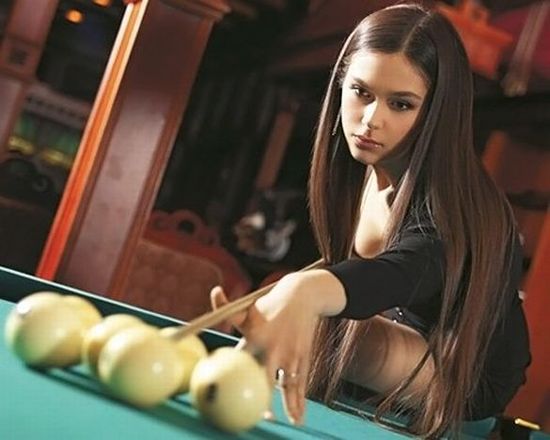
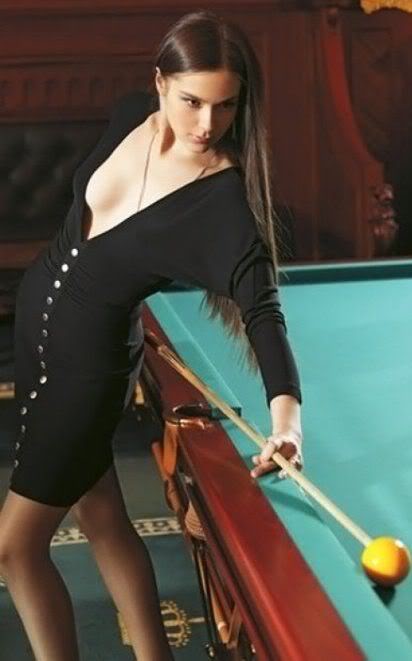
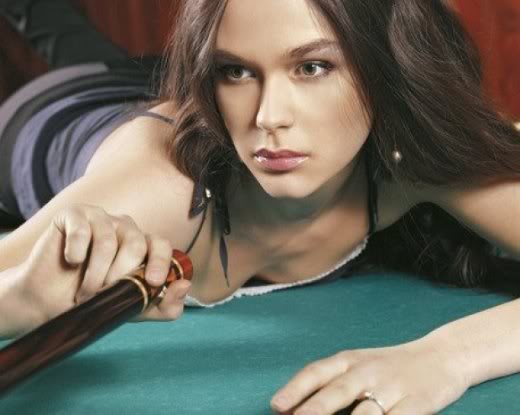
Her name is Anastasia Luppova. And don't even dream about playing any of these guys for
money, regardless of what they're wearing ...
The best money players of all time: Ronnie "Fast Eddie" Allen, Billy "Cornbread
Red" Burge, Vernon "Burnie" Elliot, Leonard "Bugs" Rucker, "Titanic" Thompson,
Buddy "The Rifleman" Hall, Keith "Earthquake" McCready,
"Saint Louie" Louie Roberts, Rudolf "Minnesota Fats" Wanderone,
Don Willis
While Minnesota Fats many not have been on par with run-out specialists
like Ronnie Allen and Buddy Hall, when it came to money-making
"propositions" he was second to none. The goal of hustling is to end up with the
loot, and by that measure Fats was a world champion. Still, it's hard to imagine
Fats trying to match up with Buddy Hall, much less beating him, at nine ball.
"Until you've received a spanking from Mr. Buddy Hall, you don't
know what perfect pool is about." — Alfie Taylor
The most intimidating pool sharks of all time: Buddy "The Rifleman" Hall, "Titanic"
Thompson
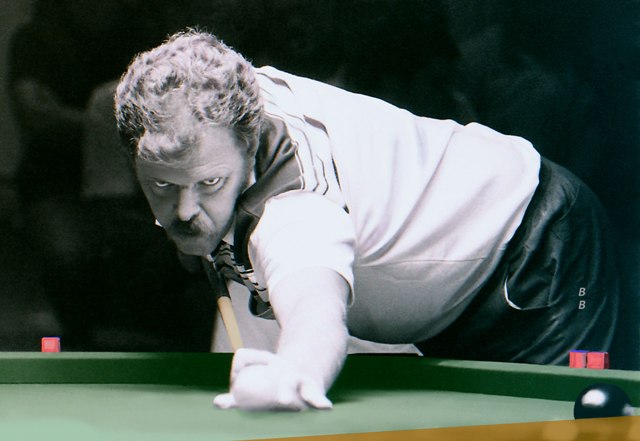
The photo above is of Buddy "The Rifleman" Hall taken in 1986 by
Billie Billing. Hall, the picture of intensity, seldom looked happy at a pool
table, even when he was winning in a cakewalk (which he usually was).
"Titanic" Thompson, aka Alvin Clarence Thomas, earned his nickname because when
it came to gambling, he was always sinking his opponents, whether at billiards,
golf, dice, horseshoes, cards, or various other "propositions." He allegedly
killed five men (each of whom, according to him, would have admitted they got
what they deserved!). Minnesota Fats called him "the
greatest action man of all time." Ben Hogan said that he was the best golf shotmaker
he ever saw. When asked if he would become a golf professional, Titanic Thompson
demurred, claiming that he couldn't afford the pay cut.
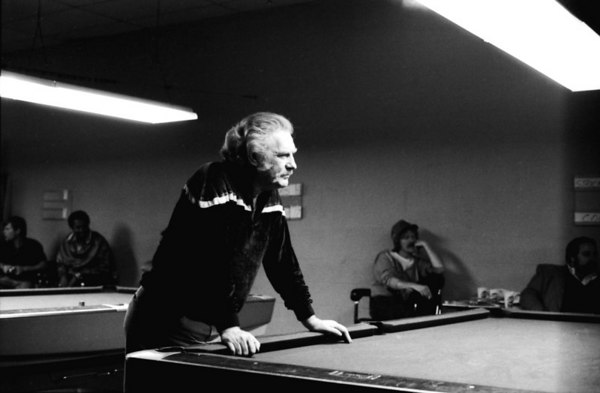
Billy "Cornbread Red" Burge, circa 1982. Several of the black-and-white
pictures on this page were taken at the 1982 Dayton Nine Ball Open, at Forest
Park Billiards in Dayton, Ohio. The billiard hall was owned by Joe Burns at
that time. These striking photos were taken by Mike Haines; the photo editing was done by
Bill Porter. My thanks to them for their excellent (and artistic) work.
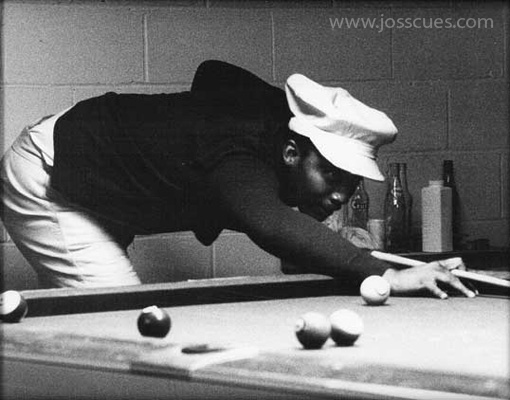
Leonard "Bugs" Rucker, circa 1982.
The best "undercover" hustlers and players (the ones the general public still hasn't
heard about): Richie Ambrose, Glenn Atwell, Smokey Bartlett, Jafar Basheer aka "Patch
Eye," Jerry Brock, Eugene
Browning, Jack Cooney, Warren "The Monk" Costanzo, Rod "Surfer"
Curry, Vernon "Burnie"
Elliot, Ricky Gracyk,
Peter Gunn, Horace Harper, Bingo Harrison, Dennis Hatch, Larry "Gabby" Hill,
Norman "Hitch" Hitchcock, Bud Hype, Tom Jennings, Bill Lawson, Dan Louie, Dick Lane,
Frank Lively, Henry "LotsaPoppa" McCloud Jr., Peter Margo, Jimmy Matz, Chuck Morgan, Johnny Morrow,
Willie Munson, Gary "The Bushwhacker" Nolan, Reed Pierce, Gary Serville, Sam Soto, Gary Spaeth, Sonny Springer, Roy "The Cook" Stanzioni,
"Hippie" Jimmy
Reid, David Rhodes, Weldon Rogers, George Rood, Denny Searcy, Ray Schultz,
Bernie Schwartz, Randy "The Exterminator" Smith, Greg Stevens, Jay Swanson, Toby
Sweet, Mark Tadd, Danny "High Heels" Tator, Cheyenne Pete Trujillo, Cecil
Tugwell, Howard Vickery, Nick "the Indian" Vlahos, C. J. Wiley, Don
Willis, Rob "Roadplayer" Wolfe, Harold "The Best" Worst, Mike Zuglan
There is an account that Danny "High Heels" Tator was in
danger of going to jail on a drug count unless he could explain the source of
his income and impressive jewelry. Buddy Hall appeared as an expert witness and
told the judge that Danny played pool at a professional level.
The best big money players: Ronnie "Fast Eddie" Allen, Jack "Jersey Red"
Breit,
"Jew" Paul Brusloff, Billy "Cornbread Red" Burge, Clyde Childress,
Jack Cooney, Vernon "Burnie" Elliot, Minnesota Fats, Richie Florence, John
"Rags" Fitpatrick, Buddy "The Rifleman" Hall, Jose Parica, Efren "Bata" Reyes,
Kenny "Romberg" Remus, Leonard "Bugs" Rucker,
Jimmy "Flyboy" Spears, Sonny Springer, Eddie "The Knoxville Bear"
Taylor
This was posted online by Keith McCready: I am really sad to hear about
Vernon Elliott. I consider him a good friend of mine. I knew he was sick. God
bless him. He was one of the better guys in the pool business. There's probably
a lot of people that don't know who Vernon was, but I had the privilege of
knowing him as a nice person, good heart, and a bar table champion, as well as a
bank pool champion, one of the best bankers I've ever seen for the money. That's
one thing Vernon could do is play for the dough. I think it was in the early
'80s or thereabouts when I was over there in Knoxville during the World's Fair.
I was sneaking in around from bar to bar to bar, trying to stir up some action.
I made a few good scores and was feeling my oats. The first time I ever met
Vernon Elliott was during this time. I stepped into one bar with only about
three or four people in it. They had a few bar tables in there. I said, "Where's
all the action around here?" hoping I'd get a nibble. Boy, did I ever get the
big kahuna. Vernon, unbeknownst to me, said, "I'll play you some," and I asked
him what do you want to play for. He said, "I'll play you some, fifty or a
hundred a game." I looked at this guy and thought I was stealing because Vernon
didn't look like a pool player to me. Was I ever mistaken. LOL. He got up there,
run a 5-pack for 50 a game. I asked him if he wanted to bet a 100, hoping that
he might start missing balls. He laughed at me and said, "Bet." Well, he got up
and run another 7 and broke me. So I went and got some more money and came back.
All I could round up was another 500. Well, he ran 5 more racks. He put me into
a complete coma. That was my introduction to Vernon Elliott. We talked some at
the bar and he let me snap him back for a hundred, so I had a little walking
money to go hustle some more bars, but I said to myself right then and there
that I would be leaving Vernon alone and he wouldn't be on my hit list. We
actually became good friends after that. I watched him over there in Detroit
betting as high as you could fly, some of the best pool I've seen for the money,
and I'm talking about big money, not just 5 and 10,000 a set. They were playing
15 and 20,000 a game. That was Vernon Elliott. Rest in peace, Vernon. You will
be missed.
Move buffs may be interested to know that a number of players mentioned here appeared in the 1986 movie The Color of Money and/or served as technical advisers. Sharks with speaking roles
included Steve "The Miz" Mizerak, Grady "The Professor" Mathews, and Keith
"Earthquake" McCready. There were cameo appearances by Jimmy "Pretty Boy Floyd"
Mataya, Mark Jarvis, Howard Vickery and "Saint Louie" Louie Roberts. Mike "Captain
Hook" Sigel was the movie's technical director. Sigel and Ewa Mataya Laurance, aka "The
Striking Viking," served as technical consultants and performed shots. Paul Newman won an Oscar
for his portrayal of an aging "Fast Eddie" Felson, whose cocky protégé,
Vincent "Vince" Lauria, played by Tom Cruise, seemed a lot like his younger self.
From what I have read about the making of the movie,
"Saint Louie"
Louie Roberts kept a large audience of extras entertained between sets, with
his showmanship at the table. Roberts rivals Fats as the most charismatic and
entertaining pool shark of all time, except that Fats was, well fat, while
Roberts looked and acted like the young, hip Elvis.
Pool legend Willie "Mr. Pocket Billiards" Mosconi had a cameo in the 1961 movie The Hustler,
one of the best sports movies of all time. It starred Paul
Newman as a young, reckless "Fast Eddie" Felson. Mosconi also
served as a consultant and executed the movie's trick shots, except for those of
the Fat Man.
Indeed, Jackie Gleason was
recommended for the Minnesota Fats role by Mosconi because he was an accomplished pool shooter. Thus,
a "wide angle" lens could be used on his shots (please pardon the pun). The Hustler
was well-received by critics and the public. It was nominated for nine Academy Awards, including best
picture, Newman for best actor, Piper Laurie for best actress, and
Gleason and George C. Scott for best supporting actor. The film won two Oscars, for art
direction and cinematography. There is more information about both movies and the real-life sharks who
helped create their cinematic magic, later on this page.
How good was Willie Mosconi? Pretty damn good. His best game was straight pool, but
when he matched up with Minnesota Fats gambling at one pocket in the
early 1950s, Fats reportedly asked his backers for more money, saying:
"Willie has no idea how to play this game, he just keeps running eight and out!"
I've seen top road players like Buddy Hall do the same thing. When they want to
win money fast, they can shorten slower games like bank and one pocket by
going on the offensive, knowing that more often than not, they can get out. And
they can demoralize their opponents at the same time. Fats may have out-hustled
most of the shortstops he played, but what, pray tell, is the defense against a
true master's continual table runs?
James Coburn and Omar Sharif played big-stake pool hustlers in the 1980 movie
The Baltimore Bullet, which featured cameos by a number of real-life
sharks who played themselves: "Machine Gun" Lou Butera, Irving "The Surgeon"
Crane, Richie Florence, Allen "Young Hoppe" Hopkins, Pete Margo, Ray "Cool Cat"
Martin, Jimmy "Pretty Boy Floyd" Mataya, Steve "The Miz" Mizerak, Willie
Mosconi, Jim "King James" Rempe, and Mike "Captain Hook" Sigel. (Mosconi
received top billing, with the names of the other sharks appearing below his in
alphabetic order.) The movie involves one of the Jansco brothers' legendary
Johnston City "pool hustler" tournaments, which ran from 1961 to 1972
and really did attract
players like Butera, Crane and company. And the movie's FBI bust actually
happened in 1972, killing the action. But it's a bit anachronistic that the movie centers around
straight pool. As Danny DiLiberto pointed out, the Janscos "were the ones
to really throw out straight pool," as they preferred the more entertaining
gamblers' games of nine ball and one pocket. In The Baltimore Bullet,
Coburn plays an aging "Fast Eddie" character similar to Newman's in The
Color of Money, Bruce Boxleitner plays his brash protégé in a role similar
to Cruise's, while Sharif plays a far more suave Minnesota Fats. Since TBB
came out several years before TCOM, one might suggest that TBB
is the more original of the two, with both paying homage to The Hustler.
And while I have seen TBB being panned here and there for not being as
profound as its progenitor, it's a comedy not meant to be taken
too seriously, and I found it to be both
entertaining and enjoyable.
Minnesota Fats played himself in the 1971 movie The Player, which I
believe had only a limited release. While Fats was probably not the absolute
best pool player (despite his many verbose assertions to the contrary), he was
nonetheless a top shark, not the shortstop some revisionists have tried to turn
him into. As Larry Gunninger has pointed out, when the Johnston City tournaments
were in full swing, attracting the cream of the pocket billiards crop, it was Fats who
ended up with most of the moolah. And as Muhammad Ali suggested, "It ain't
braggin' if you can back it up."
Poolhall Junkies is a somewhat obscure
movie starring Christopher Walken (who made his one trick shot on the first
attempt). Robert "Cotton" LeBlanc served as a technical adviser, had a cameo,
and performed most of the trick shots. Ironically, Mike "Tennessee Tarzan"
Massey, who played "St. Louie" Louie Roberts in the movie, didn't shoot any
of the movie's
trick shots, even though he's probably the world's most
famous trick shot artist.
Country music legend Johnny Cash, the "Man in Black," played a pool hustler in
the made-for-TV movie The Baron and the Kid.
W. C. Fields starred as a hustler in the first film he made, the 1915 silent
movie Pool Sharks.
"The best game on earth." — Mark Twain, who was perhaps America's best and sagest writer
(and perhaps its most passionate pocket billiards enthusiast)
Unknown "monster" players who could play with anyone on a given day: Eddie
Adams, Richie Ambrose, Glen Atwell, Mike Bandy, Smokey Bartlett, Danny Barouty,
Mike Blevins, Terry Boucher, Donny Branson, Larry "Gabby" Brown, Eugene Browning
(bar box), George Brunt, Clyde Childress, Dan "Clarkie" Clark, Warren "The Monk"
Costanzo, "Baltimore" Buddy Dennis, "Fat" Harold Dollar, Don "Water Dog"
Edwards, Ed Eversole, Vadis "Meathead" Eversole, Brian Ezell, Sebastian "Chino"
Franco, Roy Futternick, Leil "JR" Gay, Rich "The Hat" Geiler, Mike "Geese"
Gerace, Wayne Giles, Junior Goff, Ricky Gracyk, Billy Graves, Steve "The Gump/Gumpster"
Gumphries, Peter Gunn (real name Len Wesson), Horace Harper, "Bakersfield" Bobby
Hernandez (bar box), Pete Horne, Dick Hunzicker, Tommy Kennedy, "Chicken" George Kieselat, Bobby
Logan, Dan Louie, "Marlboro," Mike McClain aka "Little Mikey" and "The Dwarf"
and "Pittsburg Mike," Kenny McCoy, Chuck Morgan, Johnny Morrow, Leo Newberry,
Gary "The Bushwacker" Nolan, Curtis "The Mountain Man" Payne (also "King
Curtis), Richard Peck, David "Dough Boy" Rhodes, Charlie "The Ape" Romanis,
George Rood, John Rouse, Johnny Ross, Joe Salazar, Ray Schultz, Bernie Schwartz,
Brad "Bullwinkle" Schwartz, "Navy" Gary Serville, "Omaha" John Shuput, Randy
"The Exterminator" Smith, Sam Soto, Roy "The Cook" Stanzioni, Chris Szuter, Mark
"Tadd" Tademy, Danny Tator, Brian Tidwell, Cheyenne Pete Trujillo, "Cigar" Tom
Vanover, Sebastian "Vera Cruz" Villaneuva, Nick "The Indian" Vlahos, James
Walden, Don Watson, Sparky Webb, Billy Weir
According to "Toupee" Jay Helfert, Keith McCready went looking for "monster" players.
The best one-handed players: Ronnie Allen, Jesse "The One-Handed Hustler" James,
Martin "Omaha Fats" Kaiman, Ernie Morgan, Chris Raftis, Richard T. Riggie,
"Little" Sergio
Notorious Sharks, Part I: The most notorious pool shark in history may have been
John Wilkes Booth. According to Henry Hogan, after his acting performances were
over, Booth would hurry down to Joe Dillon's billiard hall to play with the
"best in the city." He was also said to have frequented the Miller Billiard Parlor,
located on the second floor of the National Theater Building (where the Helen
Hayes Gallery now resides). On April 13, 1865, Booth dropped by Grover's Theatre
and asked C.D. Hess if President Lincoln was going to be invited to attend Aladdin
or The Wonderful Lamp. Hess assured Booth that Lincoln would
be invited. Booth then went upstairs to Deery's Billiard Saloon, located above
the lobby of Grover's Theatre, where he drank whiskey until eight in the
evening. Booth asked the
saloon's owner, John Deery, a national pool champion, to secure him tickets for the box that adjoined the box where the
Lincolns would be sitting. According
to what Deery told the New York Times in an
article published on October 5, 1921, Booth had been drinking all day, before
he shot the president. According to another account by Ernest C. Miller,
Deery said: "For a period of about ten days before the assassination, he visited
my place every day, sometimes in the afternoon, sometimes in the evenings. At
this time he was out of an engagement and drinking quite freely, noticeably so,
even for him, I thought. At times he seemed a bit crazed, apparently on account
of the frequency of his potations ... During that last week at Washington he
sometimes drank at my bar as much as a quart in the space of less than two hours
of an evening ... I believe Booth was as much crazed by the liquor he drank as
by any motive when he shot Lincoln."
The best tournament players: Johnny "The Scorpion" Archer, Ralph "The Showman" Greenleaf, Buddy "The
Rifleman" Hall, Allen "Young Hoppe" Hopkins, Luther "Wimpy" Lassiter, Willie Mosconi, Steve "The Miz" Mizerak,
Jim "King James" Rempe, Efren "The Magician" Reyes, Mike "Captain
Hook" Sigel, Earl "The Pearl" Strickland
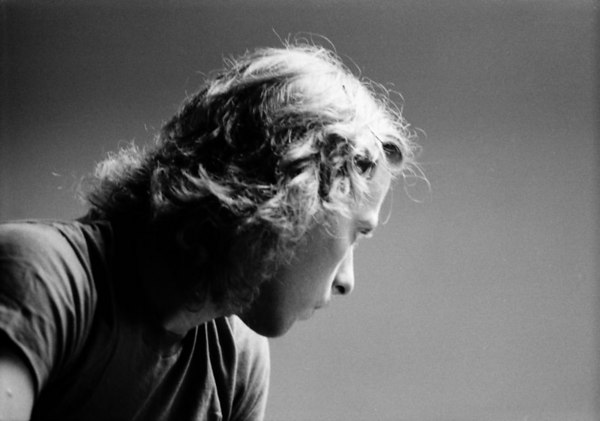
The picture above is of Earl "The Pearl" Strickland, at the 1982 Dayton
Nine-ball
Open. That was, I believe, the first pro tournament that he won, against a loaded field which
included Billy "Cornbread Red" Burge, Steve "Cookie Monster" Cook, Danny DiLiberto, Buddy
"The Rifleman" Hall, Allen "Young Hoppe" Hopkins, Jimmy "Pretty Boy Floyd" Mataya,
Grady "The Professor" Matthews, "Hippie" Jimmy
Reid, "St. Louie" Louie Roberts, Mike "Captain Hook" Sigel, and various other pool gods,
demigods, contenders and pretenders.
The best jump shot: Fong Pang Chao, Niels "The Terminator" Feijen,
Po Chen Kuo, Alain "The Dancing Bear"
Martel, Earl "The Pearl" Strickland,
Yang Ching-Shun the "Son of Pool"
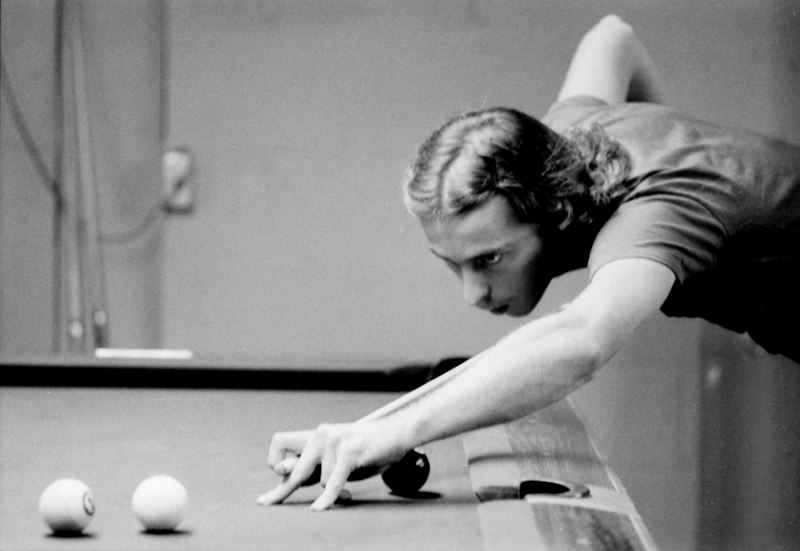
I first saw Earl Strickland at the Music City Nine-Ball Open,
held at the ritzy Nashville Maxwell House Hotel, circa 1982-1983. The Pearl had bobby pins holding back his long, flowing mane, and he
was giving Buddy Hall serious grief with his amazing jump shots and spectacular shotmaking.
When in Nashville, if I remember correctly, the Pearl spotted all comers the
seven ball. If he ever lost money giving up the seven in
Nashville, I never heard about it. I believe Mike Sigel won the Music City Open
in 1982, and Ray "Cool Cat" Martin won in 1983, coming out of the losers' bracket to defeat
Larry Hubbart. But the player I remember best is Earl the Pearl, resplendent in
bobby pins, jumping balls and running out.
The best shot makers and thin cutters: "St. Louie" Louie Roberts, Keith "Earthquake" McCready
It has been my good fortune to have seen some of the best tournament pool
players, sharks and hustlers in the flesh. The ones I remember best are Johnny Archer, Michael Coltrain, Buddy Hall,
Truman Hogue, Allen Hopkins, David Howard, Jeanette Lee, Mike Massey, Keith McCready,
Alex Pagulayan, Mike Sigel, Earl Strickland and Nick
Varner. I even saw Steve Davis score a perfect 147 in snooker. (I was on vacation in
England when he hit the magical number, in a match televised by the BBC.) But
the most charismatic, exciting and crowd-pleasing pool player that I have ever seen
personally was
"Saint Louie"
Louie Roberts". He was an incredible,
fearless shot-maker. There was something otherworldly about his game, when he was "on." I remember watching him advance through the
losers' bracket at the 1981 U.S. Open Nine-ball Championship, promoted by Mike
Massey at the Downtown Sheraton Hotel in Chattanooga, Tennessee. As I remember things, Roberts had lost his opening round match,
and then almost lost a second time to the little-known Nat Green.
In that match, there was a controversy about someone breaking out of turn and the referee not
catching it, so that Roberts ended up breaking the last two games despite an
alternating break format.
Roberts capitalized to win the "double hill"
game. After that, he seemed
to freewheel, drinking openly, bantering with fans, and mostly disdaining
safeties. If his opponent made a ball out of turn, and two balls
were lined up on the spot, Louie would hit the head ball with so much English
that he banked the second ball in "long rail" ... a shot that I have never seen anyone else
attempt in a major nine ball tournament. Roberts went on to defeat a perplexed Buddy
Hall, who just shook his head at Louie's showman-like
antics and incredible
shotmaking. It had been a longtime dream of
Louie's to beat Buddy Hall, who was the world's top nine-ball player at the time.
What Louie accomplished that day, and how he accomplished it, was magical, and
I'll never forget how he had the crowd eating out of the palm of his hand until
he was proclaimed the victor, to wildly delighted cheers that included my own.
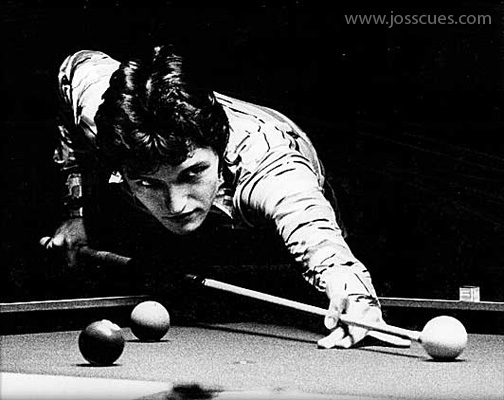
"St. Louie" Louie Roberts
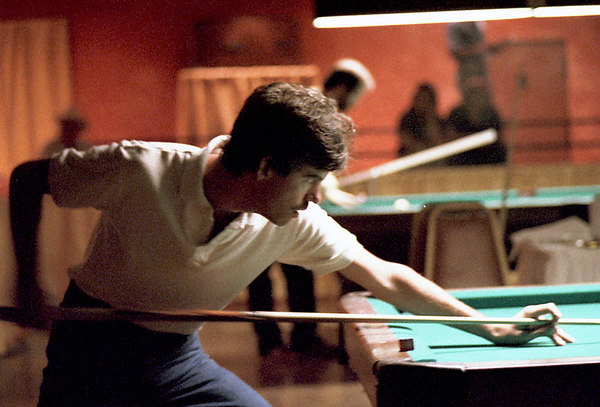
Keith "Earthquake" McCready at the 1984 River City Open
Nine-ball Tournament (photo by Mike Haines; photo editing by Bill Porter). I used
to watch McCready play golf on a snooker table at Scott Amusement
Center in
Nashville. He wasn't acting in The Color of Money ... as Grady
Seasons, he was just playing himself, to a T. When I saw him play, he
would eye a really difficult shot, say something outrageous like "God couldn't
make that ball," then pocket it.
He once ran nine straight racks of nine ball, to come from behind and
defeat Larry "The Iceman" Hubbart 11-6 in the Sacramento Open
Nine-Ball Championship, and
I believe he has confirmed that he once ran 21 racks of nine ball in
three consecutive races to 7, on a bar table.
The best nine-ball players: Johnny Archer, Buddy
Hall, Luther Lassiter, Keith McCready, Efren Reyes, Louie Roberts, Mike Sigel, Earl Strickland, Nick Varner,
Don Willis, Harold Worst
Honorable Mention: Ronato Alcano, Darren Appleton, Carlo Biado, Shane Van
Boening, Francisco Bustamante, Jung Lin Chang, Fong-Pang Chao, Lee Vann Corteza,
Kim Davenport, Mike Dechaine, Niels Feijen, Richie Florence, Dennis Hatch, Allen
Hopkins, Dave Howard, Thorsten Hohmann, Mika Immonen, Jeremy Jones, Eklent Kaci,
Warren Kiamco, Mike Lebron, Chris Melling, Rodney Morris, Dennis Orcollo, Oliver
Ortmann, Albin Ouschan, Alex Pagulayan, Jose Parica, Reed Pierce, Ko Pin-Yi, Jim
Rempe, John Schmidt, Jayson Shaw, Evgeny Stalev, Ralf Souquet, Billy Thorpe
Johnny "The Scorpion" Archer has won more than 60 professional tournaments and
was voted the best player of the 1990s by Billiard Digest.
The History of Pool, Part I: The game of billiards dates back at least to the 1300s, at which time
it was an outdoor game similar to croquet and golf. It seems likely that wealthy people wanted to enjoy
billiards when the weather was bad, and were willing to pay substantial amounts of money to have the
game brought indoors. This may explain why billiard table covers were historically green, as they
represented a grass playing field. The rails resembled river banks; hence the
term "bank shot." The earliest versions of billiards included arches similar to
croquet hoops, and maces similar to golf clubs. (In fact, the term "cue" derives from the French word
"queue," which means "tail." The thinner "tail" was used when a ball was too close to the rail for the bulky
mace head to engage it.) The first pool table on record, built for Louis XI by the carpenter Henry de Vigne
around 1470, had a bed of stone covered with cloth and a "hole at the centre,
into which the balls were driven." So the first documented billiard table sounds
like a putting green! The first female billiards shark may have been Marie
Antoinette. She had an exquisite cue carved out of a single piece of ivory,
which was inlaid with gold. She kept the cue in a special locking cabinet and
wore the key around her neck.
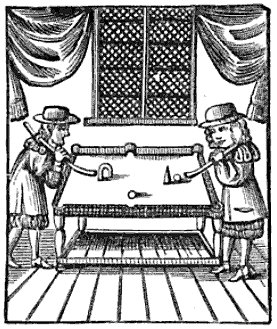
Notorious Sharks, Part II: One of the most famous pool sharks was a French
infantry captain, Francois Mingaud. In 1807 he introduced the leather cue tip,
which provided gripping power and allowed the use of spin (ironically
now called "english"). Allegedly, Mingaud developed techniques of controlled
spin while playing billiards in a Paris prison, and when eligible for release he
requested to serve further time in order to improve
his techniques! He has been credited with the application of extreme spin known
as the massé (a French word related to "mace"). John Carr, who worked in a
billiard hall in Bath as a marker, has also been credited with the invention of the "side
stroke" which became known as "english." Carr became "England's champion
billiardist" with an astonishing (for the time) run of 22 consecutive made
shots. He explained his prowess as being due to a special brand of "twisting
powder" which he sold to other players for considerable sums of money, due to its
magical properties. Little did they know that it was ordinary chalk. In any
case, leather cue tips and chalk are still standard fare in pool rooms around
the world today (although modern pool chalk is no longer of the blackboard
variety).
Notorious Sharks, Part III: In 1828, opponents of President John Quincy Adams
charged that he kept "gaming tables and gambling furniture" in the White House.
According to Edwin A. Miles, the president's billiard table "served as the
keynote" for political attacks on Adams, in what quickly became one of the
dirtiest presidential campaigns in American history. His owning
a billiard table was used by his enemies to portray Adams as an
aristocrat, so at least he was an upper crust shark, according to them!
Notorious Sharks, Part IV: The enemies of John Quincy Adams were obviously unaware that the
father of their country was a pool shark! George Washington kept detailed records of his wins and
losses at billiards in his diaries. So we know that his biggest score was $1.75, a tidy sum in those
pre-inflation days.
Notorious Sharks, Part V: According to the Brunswick billiard table company website, "The first
real American celebrity who owned a Brunswick table was an immensely important person in American
history—Abraham Lincoln. Lincoln was a self-confessed 'billiards addict.' He described the game as
a 'health inspiring, scientific game, lending recreation to the otherwise fatigued mind.'" General
George Armstrong Custer also owned a Brunswick table, and Buffalo Bill Cody bought Brunswick tables
for his hotel in Cheyenne.
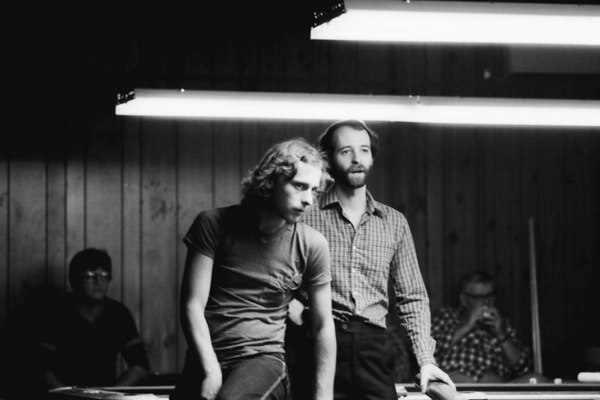
Earl "The Pearl" Strickland and Mike "Captain Hook" Sigel looking intense at the
1982 Dayton Nine-ball Open.
The best showmen: Ralph "The Showman" Greenleaf, Jimmy "Pretty Boy Floyd" Mataya,
Utley Jim "U.J." Puckett, "St. Louie" Louie Roberts, Rudolf
"Minnesota Fats" Wanderone
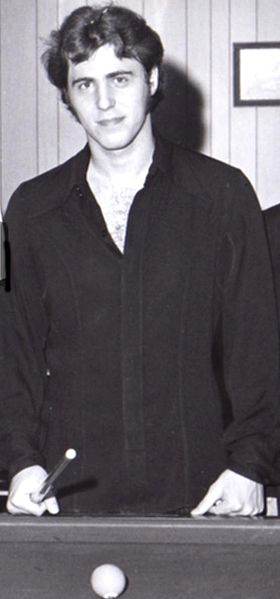
Jim Mataya, also known as "Pretty Boy Floyd," formed pool's first "power couple"
when he married the "Striking Viking," Ewa Svensson, in 2004. They helped
bring some much-needed glamour to the often-seedy sport of pocket billiards.
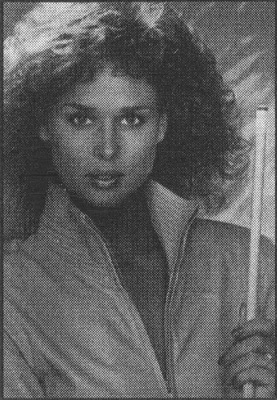
Ewa Mataya, "The Striking Viking."
The Women's Professional Billiard Alliance (WPBA) was established in 1976 and is
the oldest pro player organization in the sport. The WPBA sanctions and produces
the Women's Pro Billiard Tour, which features ESPN-televised events between the
world's greatest women players.
The best early WPBA tour players: Jean Balukas, Robin "Bankroll" Bell, Belinda Campos, Vickie Frechen
Paski, Ewa "The Striking Viking" Mataya Laurance, Loree Jon Ogonowski, Lori
Shampo, Gloria Walker
Other notable female pool players: Borana "Killer B" Andoni, Mary
Avina, Jennifer Barretta, Brittany Bryant, Yu Ram Cha, Jennifer Chen, Karen Corr,
Christina De La Garza, Emily Duddy, Allison "The
Duchess of Doom" Fisher, Kelly Fisher, Liz Ford, Olga Gashkova, Gail Glazebrook, Gerda
Hofstaetter, Ina Jentschura, Ga-Young Kim "the Little Devil Girl,"
Line Kjorsvik, Jeanette "The Black Widow" Lee, Michelle Li, Shanelle Loraine,
Jasmin "Jassy" Ouschan, Angelina
"Angel" Paglia, Xiaoting Pan, Nataliya Seroshtan, Kim Shaw, Fraziska
Stark, Helena Thornfeldt, Vivian
"Texas Tornado" Villareal, Monica Webb
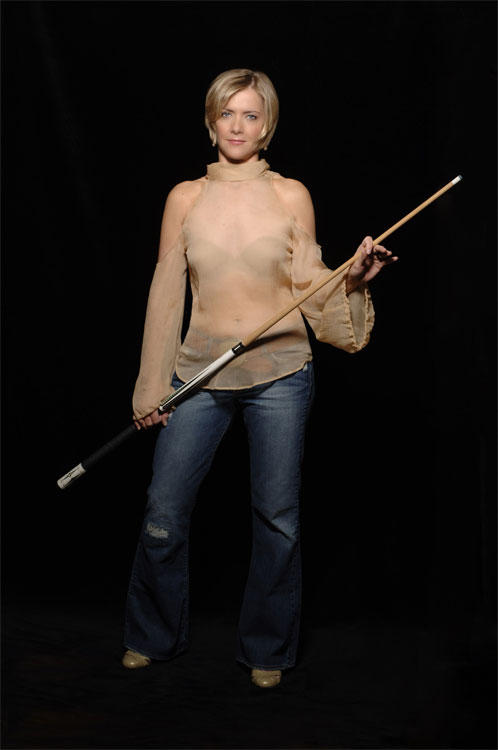
Allison Fisher, "The Duchess of Doom"

Jeanette Lee, "The Black Widow"

Vicki "Diamond Vic" Frechen (now Vicki Paski) was a top ten WPBA player during the 1980s,
rising as high as number two in 1981. She was the Pool & Billiard Magazine
player of the year in 1982. She is also a member of the WPBA Hall of Fame. In 1985
she was elected vice president of the WPBA. In 1987 she became ESPN's first
female billiards analyst. In 1991 she was elected president of the WPBA.

Jean Balukas, the first female superstar of pool, already a shark at age six.
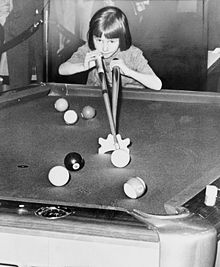
"The game of billiards has destroyed my naturally sweet disposition." — Mark Twain, April
24, 1906
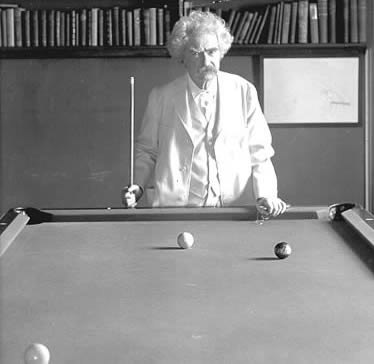
“This is a most amusing game. When you play badly it amuses me, and when I
play badly and lose my temper it certainly must amuse you.” — Mark Twain
Celebrity sharks: Jackie Gleason (as Minnesota Fats in The Hustler), Tom Cruise (as Vincent
"Vince" Lauria
in The Color of Money), Paul Newman (as "Fast Eddie" Felson in both
movies), Mark Twain, Charles
Dickens, H.G. Wells, Samuel Pepys, Mozart, Shakespeare, Van Gogh, George Washington, Thomas
Jefferson, John
Adams, John Quincy Adams, Alexander Hamilton, Abraham Lincoln, Cornelius Vanderbilt, J. P. Morgan, Mary Queen of Scots,
Louis XIV, Louis XVI and Marie Antoinette, Lafayette, Napoleon, Queen Victoria,
King George IV, Cap Anson, Babe Ruth, Frank Sinatra, Milton Berle, Bob Dylan, Woody Allen, Ozzy Osbourne, Elvis Presley,
Dr. Martin Luther King Jr.
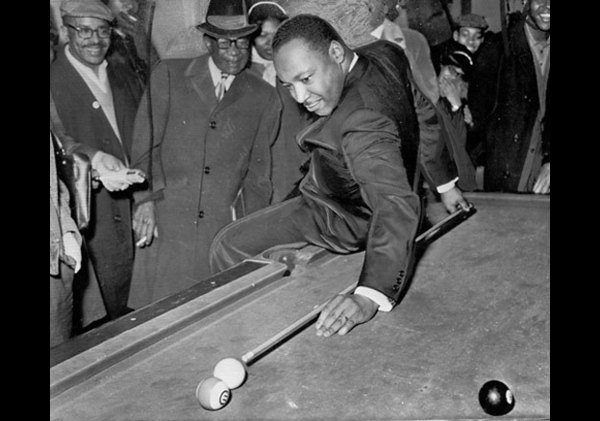
Dr. Martin Luther King Jr. shoots the eleven ball behind his back!
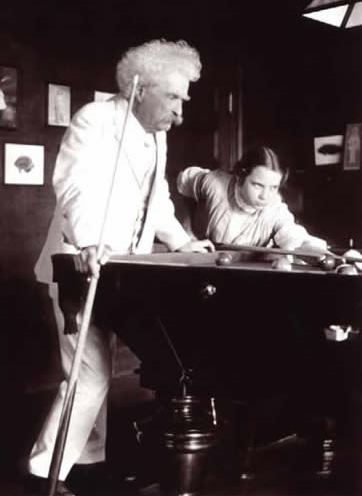
“The poorer you play, the better I shall like it.” — Mark Twain, who was intensely devoted to the game of pool
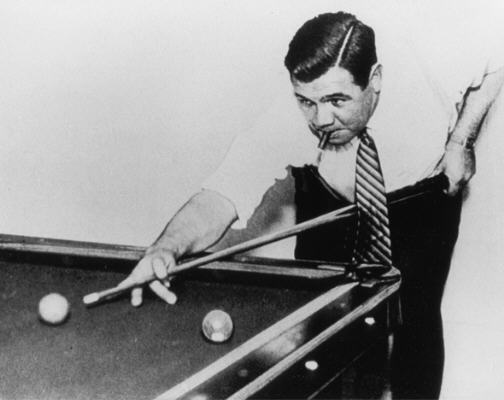
Babe Ruth played pool. But another hall of fame baseball player was probably
better ...
Famous Sharks, Part I: Baseball hall-of-famer "Cap" Anson (Captain Adrian Constantine Anson)
was a strong billiards player. Anson was the first major league baseball
player to get 3,000 hits, and over 100 years after his retirement, he still
holds several Cubs franchise records, including most career hits, runs, doubles
and runs batted in. He joins Babe Ruth and Hank Aaron as the only major league
baseball players with more than 2,000 runs batted in. After his retirement from
baseball, Anson opened an emporium in Chicago which was
billed as having "the largest and best equipped billiard and pool rooms in the
world." On December 9, 1910, in a tournament at the Union Billiard Academy,
Anson gave George W. Moore, a world champion billiardist, all he could handle,
losing 50 to 42 in a race that was neck-and-neck until Anson went scoreless
after being up 42 to 41. According to the World Almanac and Encyclopaedia,
just two days earlier, Moore had set a new three-cushion billiard record for
consecutive shots made, at 15. That was in a tournament against world-class
opponents such as Alfredo de Oro and John W. Daly. Moore won a world title in
1915 and had a number of wins over de Oro, who was fourth in the Billiards
Digest rankings of the 50 Greatest Players of the Century. So Cap Anson was
obviously no bush-leaguer, if he was able to take
Moore to the limit. According to a New York Times article published the
following day, Anson showed "remarkable form" and had two runs of five billiards
before he ran out of steam at the end.
The History of Pool, Part II: By the mid-19th century, elephants were being
slaughtered for their ivory at an alarming rate, primarily to keep up with the
booming demand for billiard balls. Records show that in 1890 approximately 750 tons of
ivory entered England via London alone. It was said that at peak demand some
12,000 elephants were slaughtered each year to supply England with billiard
balls. Ivory balls became very expensive; and people began to feel a moral
repulsion about such excessive slaughters. The billiard industry realized that
elephants were endangered, and that ivory was dangerous to obtain (an issue of
notable public concern at the time). Therefore, inventors were challenged to come up with
an alternative material, with a $10,000 prize being
offered by a New York supplier (around $175,000 today). John Wesley Hyatt
invented such a manufacturable material in 1869, called nitrocellulose (US
patent 50359, the first American patent for billiard balls). It is unclear if
the cash prize was ever awarded. By 1870 nitrocellulose was commercially branded
Celluloid, the first industrial plastic. Unfortunately, celluloid was volatile
in production, occasionally exploding. Legend has it that celluloid billiard
balls would occasionally explode during play, but no reliable sources have been
found to substantiate this. Subsequently, other synthetic materials were used,
such as Bakelite, Crystalite and other plastic compounds. Today most pool balls
are made of phenolic resin, an extremely strong, chip-resistant plastic.
The quirkiest strokes: Willie "The King" Hoppe, Allen "Young Hoppe" Hopkins, Keith "Earthquake" McCready, James "Cisero" Murphy, Efren "Bata
(The Kid)" Reyes
Some of the greatest players have had highly unusual strokes. Willie
Hoppe's peculiar style of stroke was a result of his starting so young, as a
child prodigy. He barely reached the table and had to stand on a box. In his
book Billiards As It Should Be Played, Hoppe emphatically advised players not to
copy the way he employed the cue stick.

James "Cisero" Murphy was the first African-American professional pool
player to win national and international titles. Murphy was inducted
into the BCA Hall of Fame in 1995. He is the only player in the history of pocket
billiards competition to win a world title on his first attempt.
The best black players during the bad old days of racial segregation when they
couldn't compete in the major billiards tournaments: "Patcheye" Basheer,
Melvin "Strawberry" Brooks, Johnny "Cannonball" Chapman, James Evans, Andrew "The Gent" Gentry,
"Marvelous" Marvin Henderson, Leonard "Bugs" Rucker, Mark "Tadd"
Tademy, Cliff "Spotmaster" Joyner, Cecil Tugwell, Willie Munson, Buffalo Jerry,
Rotation Slim, James "Cisero" Murphy, "Lucky Charms" aka "Sizzle" Adams, Bus Driver,
Ike Runnels, Henry "LotsaPoppa" McCloud Jr., Javenly "Youngblood"
Washington, Edgar "Shake and Bake" White,
Robert "Rags" Woods
The History of Pool, Part III: The first player recognized as the
English Champion was John Carr of Bath. However, in 1824 when a deciding match
for the champion's title was arranged with Edwin (Jonathan) Kentfield, Carr failed
to appear. Kentfield then became known as "the first player in the world." He
remained so until 1849 when John Roberts challenged Kentfield. Kentfield "pulled
a Carr" and failed
to arrive for the proposed match, so Roberts claimed the title of "first player
in the world" by default.
The History of Pool, Part IV: During the 1850s, Michael Phelan and his
associates began making a significantly different American style of billiard
table. The cushions were lower in height and the pocket openings became
"sharply cornered" in contrast to the gradual curvature of the English cushion
(as with snooker tables to this day). Phelan became recognized as "the Father of
American Pocket Billiards." Pool became so popular in the United States
that during the Civil War billiards sometimes received greater press coverage
than the battles.
The History of Pool, Part V: In 1870 the first official English championship was
played (finally!) between John Roberts and William Cook. This match was regarded as
being of such
importance that it was attended by the Prince of Wales. Cook took the title from
John Roberts. Some five years John
Roberts Junior took the title from William Cook and was regarded as the
foremost billiard player in the world until his retirement in 1909. The term
"pool room" probably became associated with pocket
billiards when tables were installed in the rooms used by gamblers to pass time
while betting on horse races. Eight ball was invented shortly after 1900;
straight pool followed in 1910; nine ball around 1920.
The best foreign/international pool players: Ronato Alcano,
Darren Appleton, Nick van den Berg, Carlo Biado, Karl Boyes, Francisco Bustamante, Jung Lin Chang,
Wu Chia-Ching, Lee Vann Corteza,
Steve Davis, Niels Feijen, Joshua Filler, Che Wei Fu, Stephen Hendry, Alex
Higgins, Erik Hjorleifson, Thorsten Hohmann, Raj Hundal, Mika Immonen, Eklent
Kaci, Warren Kiamco, Florian Kohler, Po-Cheng Kuo, Alex Lely, Antonio
Lining, Chris Melling, Dennis Orcollo, Oliver Ortmann, Ronnie O'Sullivan, Albin
Ouschan, Alex Pagulayan,
Jose Parica, Daryl Peach, Stefano Pelinga, Ray Reardon, Efren Reyes, John Schmidt, Huidji See,
Mark Selby, Jayson Shaw, Ralf
Souquet, Judd Trump, Jimmy White, Charlie Williams, Jiaqing Wu, Ching-Shun Yang
The best foreign/international pool player nicknames: Ronato "Ronnie" Alcano,
Darren "Dynamite" Appleton, Nick "El Nino" van den Berg, Carlo "Lucky
Luke" Biado, Karl "Gwapo" Boyes, Francisco "Django" Bustamante, Jung Lin Chang
the "Pool Demon," Wu Chia-Ching, Lee "Vann Vann" Corteza,
Steve "The Ginger Magician" Davis, Nick "The Greek" Ekonomopoulos, Niels "The Terminator" Feijen,
Joshua "Joshi" Filler, Stephen "The Golden Boy" Hendry, Alex "Hurricane"
Higgins, Erik "Big Red" Hjorleifson, Thorsten "The Hitman" Hohmann, Raj "The
Hitman" Hundal, Mika "The Ice Man" Immonen, Warren "The Warrior"
Kiamco, Florian "Venom" Kohler, Po-Cheng Kuo the "Little Monster," Alex "Little
Napoleon" Lely, Antonio "Nikoy"
Lining, Chris "The Magician" Melling, Dennis "RoboCop" Orcollo, Oliver "The
Machine" Ortmann, Ronnie "The Rocket" O'Sullivan, Alex "The Lion" Pagulayan,
Jose "The Giant Killer" Parica, Daryl "The Dazzler" Peach, Stefano "Il Maestro"
Pelinga, Ray "Dracula" Reardon, Efren "Bata" Reyes, Mark "The Jester from
Leicester" Selby, Jayson "Eagle Eye" Shaw, Ralf "Kaiser"
Souquet, Judd "Stud" Trump, Jimmy "The Whirlwind" White, Charlie Williams the
"Korean Dragon," Jiaqing Wu the "Little Genius," Ching-Shun Yang the "Son of
Pool"
The best straight pool players: Joe "The Meatman" Balsis, "Machine Gun" Lou Butera, Jimmy Caras, Irving
"The Deacon" Crane,
Ralph "The Showman" Greenleaf, Johnny "Irish" Lineen, Peter Margo, Ray "Cool Cat" Martin, Steve "The Miz" Mizerak, Willie Mosconi, Frank
"The Inexorable Snail" Taberski
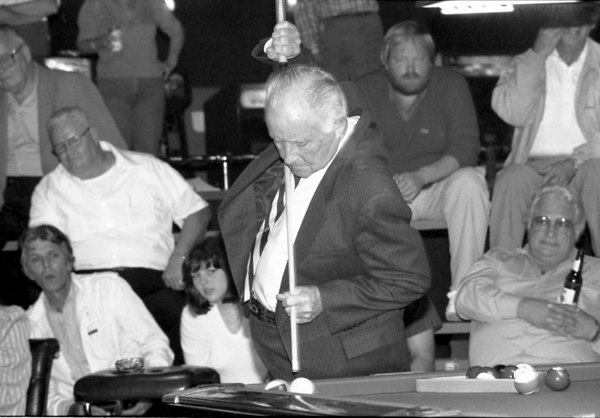
Willie Mosconi shooting a massé (1987 photo by Mike Haines; photo editing by
Bill Porter). Mosconi was second in the Billiards Digest rankings of the 50
Greatest Players of the Century, just ahead of his mentor, Ralph Greenleaf.
Ralph Greenleaf, sometimes called the "Aristocrat of Billiards," was a
twenty-time World Pocket Billiards champion who who shared sports page billing
with Babe Ruth, Jack Dempsey and Red Grange. A glamorous playboy, Greenleaf was
one of the most romantic figures of the Roaring Twenties. His wife, the former
Amelia Ruth Parker, was a flapper (vaudeville actress) who performed as
"Princess Nai Tai" and "The Oriental Thrush." I have also seen her called "The
Oriental Nightingale." In The Bank Shot and Other Great Robberies,
Minnesota Fats described her as "exquisite beyond belief" and said that
Greenleaf was so handsome he made Rock Hudson look like Quasimodo! When
Greenleaf was not competing, he toured with his wife, performing trick
shots and demonstrations. Here is how a New York Times article
describes their performances and lifestyle: "It was some kind of act. Greenleaf,
in a form fitting tuxedo, performed trick shots under suspended mirrors that
picked up the dazzling movement of the billiard balls and sent it out to the
audience, a la satellite, as the princess, in a stunning, ankle length white
ermine coat, narrated the action. The Greenleafs, with an income in six figures,
lived in penthouses and hotel suites in those plush, carefree days ..."
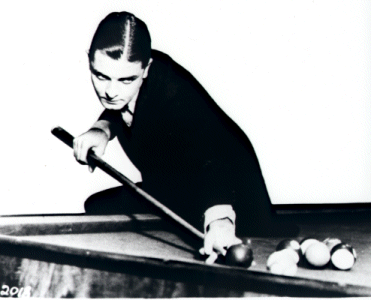
Ralph Greenleaf lines up a shot.

Peter Margo appeared in the movie "Baltimore Bullet" and on Good Morning America
and the Merv Griffin Show. He had a high run of 330 Balls in the1978 World Series of
Pool, held in Arlington, Virginia.
Joe "The Butcher" Balsis, also known as "The Meatman," won the Philadelphia City
Boys Championship at age 11, in 1932, then went on to win four consecutive
National Junior Pocket Billiard Titles. He was so famous at the time that his
picture appeared in The New York Times, alongside
pool stars Ralph Greenleaf and Willie Hoppe. But Balsis retired from
competitive pool for 32 years to work in his father's meat business (hence his
nicknames) and raise a family. When he finally unretired to compete in
professional tournaments, he took the pool world by storm. According to George
Fels: “In the first 28 months of his professional pool career, Balsis competed
in 10 major tournaments, wining five, second once, two fourths, two fifths.
Overall, between 1965 and 1975, he may well have been the world’s best player …
His peers shuddered at the thought of taking him on, just as they once had been
in awe of Mosconi.” And one competitor complained that when he shook the
Meatman's hand, his hand hurt for the next two days!
Steve "The Miz" Mizerak was sixth in the Billiards Digest rankings of the 50 Greatest Players of the
Century. He was the John Madden of pocket billiards.
The best road players and hustlers: Ronnie "Fast Eddie" Allen, Danny "Kid Delicious" Basavich, Billy
"Cornbread Red" Burge, Leonard "Bugs" Rucker, Vernon "Burnie"
Elliot, Minnesota Fats,
John "Rags"
Fitzpatrick, Richard "Little Richie" Florence, Keith McCready, "St. Louie" Louie Roberts
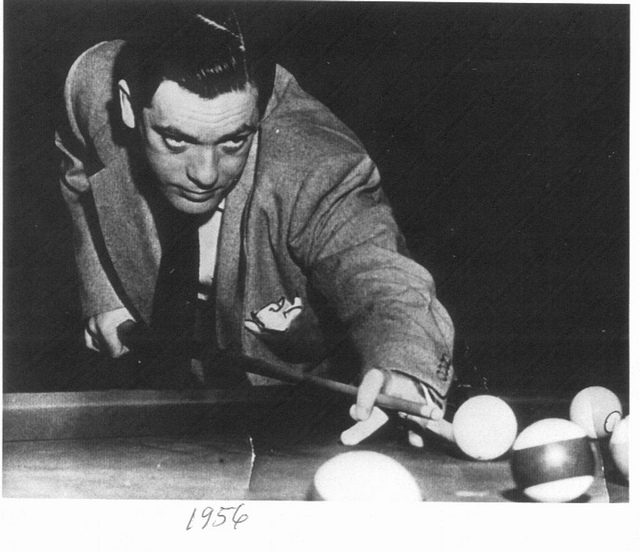
John
"Rags" Fitzpatrick looking wonderfully dapper above; his nickname was obviously
ironic. But Rudolf "Minnesota Fats" Wanderone may have pulled the ultimate
hustle. He was known as "New York Fats" and "Brooklyn Fats,"
until shortly after the movie
The Hustler came out.
Then Wanderone began calling himself "Minnesota Fats" after the Jackie Gleason
character, and pretty soon almost everyone assumed the movie had been made about
him! Fats never won a major championship, and yet became the most famous pool
shark of all time, at least with the public!
Minnesota Fats: Was he full of hot
air, vastly overrated, or a Player?
The best pool commentators who were also strong players: Buddy Hall, Allen Hopkins, Billy Incardona, Grady Matthews, Vicki Paski
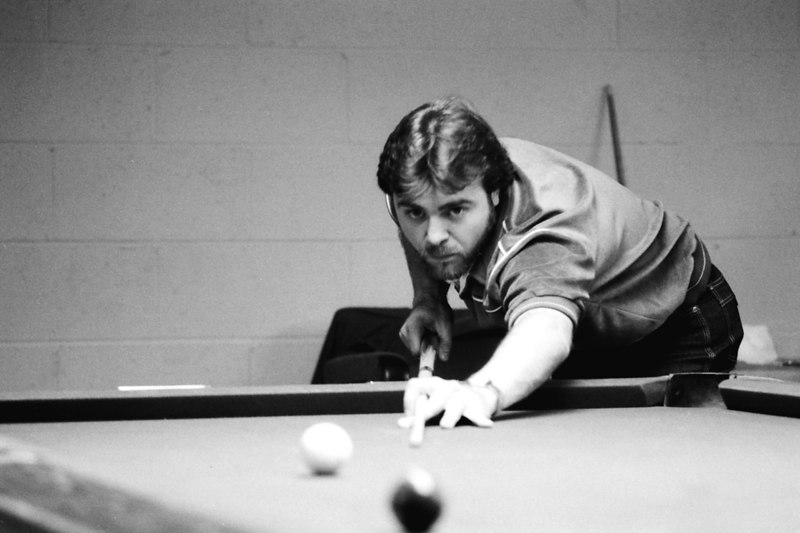
Allen Hopkins, circa the 1980s. I believe I ran into Hopkins around the time
this picture was taken, due to the beard. When Hopkins was commentating for
ESPN, he would shave, and when he was on the road he would wear a beard to make
it less likely that people would recognize him. But he was easy to identify,
once you had seen him play, because he had a very odd stroke. One night Doug
"Preacher" Almy, a friend of mine who shoots good (but not world-class)
nine-ball, made a game with a bearded stranger who called himself "John." Doug
is a good judge of talent, and even though he was ahead for awhile, once "John"
broke even with a spectacular shot, Doug walked away from the game. Doug
explained his action later by saying "He's somebody," although he didn't know
just who at the time. Not long thereafter, Doug saw "John" commentating for
ESPN, and it was Allen Hopkins, sans the beard! Around the same time, Buddy "The
Rifleman" Hall showed up in the same pool hall, so I suspect they were on the
road, headed for the next pro tournament ... probably the 1981 U.S. Open
Nine-Ball championship in Chattanooga.
The best pool nicknames: Ronnie "Fast Eddie" Allen, Marshall "Tuscaloosa Squirrel"
Carpenter, Steve "Cookie Monster" Cook, Larry "The Iceman" Hubbart, Mike "Captain Hook" Sigel, Earl
"The Pearl" Strickland, Frank "The Inexorable Snail" Taberski, "Titanic Thompson" (Alvin
Clarence Thomas), Vivian "Texas Tornado" Villareal, Edgar "Shake & Bake" White
Frank Taberski was born March 15, 1889 in Amsterdam. He grew up in Schenectady,
New York, and at the age of twenty-six he became the world champion, a title he
would hold for seven years. He was called “The Sloth” and “The Inexorable Snail”
because he played very slowly and deliberately, taking several
minutes to ponder each shot, which of course annoyed his opponents. Because of
his snail-like style, a three-minute "shot clock" was instituted. In 1919, he
forfeited his title due to illness. He joined a vaudeville tour from 1919 to
1923, and became the Harlem Globetrotters of pool, winning all 313 games he
played. In the mid-1920s, he returned to professional billiards and won four
additional titles. Taberski was seventh in the Billiards Digest rankings of
the 50 Greatest Players of the Century, despite the fact that few people have
ever heard of “The Inexorable Snail.”
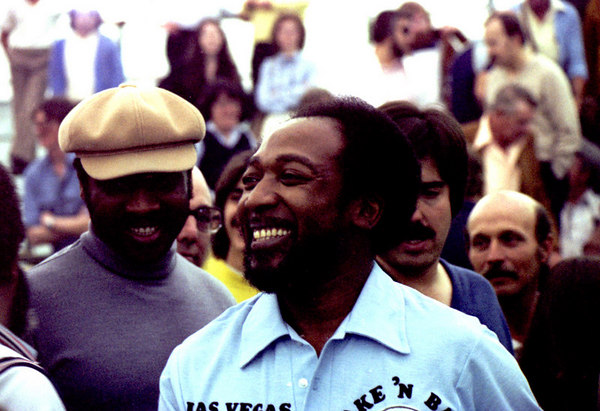
Edgar "Shake & Bake" White, always smiling.
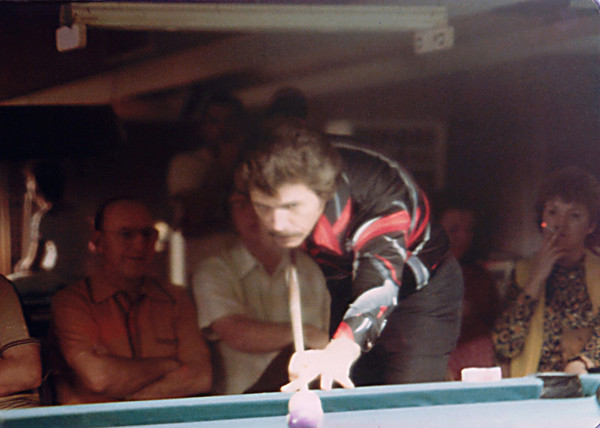
Larry "The Iceman" Hubbart (photo by Bill Johnston).
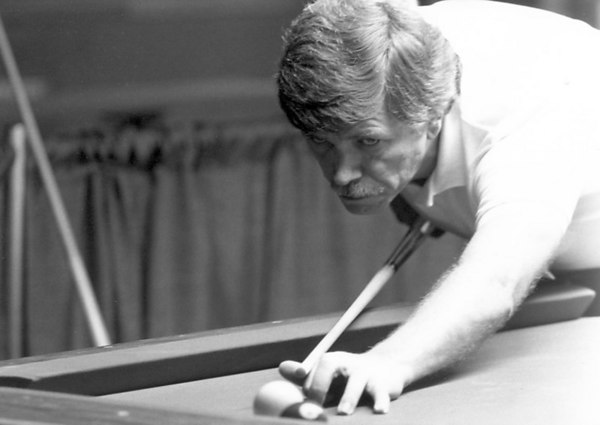
Larry "The Iceman" Hubbart (photo by Bill Porter).
The best bank players: Donnie "The Cincinnati Kid" Anderson, Freddy "The Beard" Bentivegna,
John Brumback, Billy "Cornbread Red" Burge, Johnny "Cannonball" Chapman,
Clyde Childress, Tony "Banks" Coleman,
Shannon "The Cannon" Daulton, Vernon "Burnie" Elliot, Tony "Fargo" Ferguson, Jimmy "The Philadelphia Flash" Fusco,
Buddy "The Rifleman" Hall, Truman Hogue, Mark Jarvis, Larry "The
Turtle" Price, Kenny "Romburg" Remus, Glen "Piggy Banks" Rogers, Leonard "Bugs" Rucker, Gary Spaeth,
Eddie "The Knoxville Bear" Taylor, Nick Varner, "Mexican" Johnny
Vasquez aka "Big Head," Javenly "Youngblood" Washington
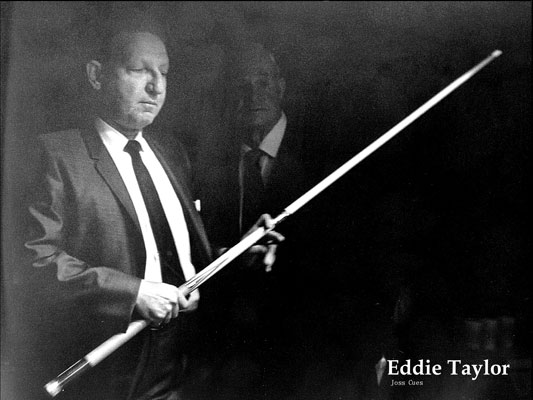
Eddie "The Knoxville Bear" Taylor is considered by many "players in
the know" to have been the best bank shot of all time.
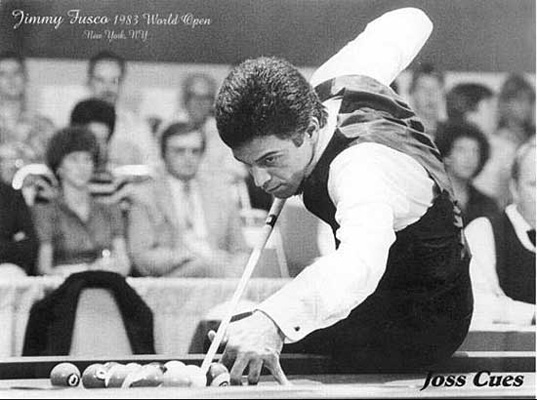
Jimmy "The Philadelphia Flash" Fusco was one of the best bankers of the modern
era, along with Buddy "The Rifleman" Hall and Nick Varner. Jimmy Fusco is the
cousin of another well-regarded player, Pete Fusco.
The best one pocket players: Ronnie "Fast Eddie" Allen, Arthur
"Artie" Bodendorfer, Jack "Jersey Red" Breit,
Melvin "Strawberry" Brooks, Billy "Cornbread Red" Burge, Marcel Camp,
Marshall "Tuscaloosa Squirrel" Carpenter, Steve
"Cookie Monster" Cook,
Hubert "Daddy Warbucks" Cokes, Jack Cooney, Shannon "The Cannon" Daulton, Danny
DiLiberto, Vernon "Burnie" Elliot, Johnny Ervolino, John "Rags" Fitzpatrick, Scott "Freezer" Frost,
Jimmy "The Philadelphia Flash" Fusco, Buddy "The Rifleman" Hall,
"Marvelous" Marvin Henderson, Allen
Hopkins, Larry "Boston Shorty" Johnson, Cliff "Spotmaster" Joyner, "Champagne" Ed Kelly,
Bill Incardona, Hayden
Lingo, Larry Lisciotti, Grady "The Professor" Matthews, Eugene "Clem" Metz, "San Jose" Dick McMorran,
Gabe "The Babe" Owen, Jose "Amang" Parica, U. J. Puckett, Efren
"Bata" Reyes, Kenny "Romberg" Remus, "Big Nose" Roberts, Leonard "Bugs" Rucker, Earl Schriver,
Gary Spaeth, Joey Spaeth, Jimmy
"Flyboy" Spears, Bill "Weenie Beenie" Staton,
Eddie "Knoxville Bear" Taylor, Cecil "The Left Duke" Tugwell, Nick Varner, Rudolf "Minnesota Fats" Wanderone,
Don Willis, Glen "Eufaula Kid" Womack,
Harold Worst
According to the pool professor, Grady Matthews, one pocket had
its genesis in Oklahoma in the 30's and Hayden Lingo was the first
great one pocket player. He was followed by "Big Nose" Roberts, Glen "Eufaula Kid" Womack, Marshall
"Squirrel" Carpenter,
Eugene "Clem" Metz, Ronnie "Fast Eddie" Allen, Jack "Jersey Red" Breit, Eddie "The Knoxville Bear" Taylor,
Johnny Vevis, and Johnny "Irish."
According to R. A. Dyer, the author of Hustler Days, two of the
all-time great one pocket players called John "Rags" Fitzpatrick the best of the
best. Eddie Taylor told Dyer that Rags was the best one-pocket player he’d ever
seen. Bill “Weenie Beenie” Staton, who played Rags, said “He was the best
one-pocket player during his era ... there wasn’t anybody close to him ... the
closest to him was Eddie Taylor, and he was a ball under him.”
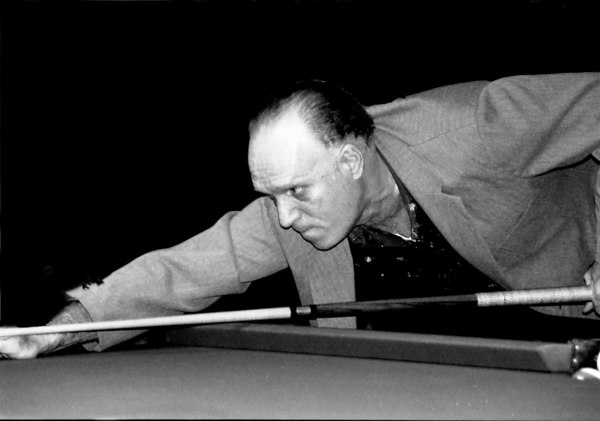
Jack "Jersey Red" Breit (1987 photo by Mike Haines; photo editing by Bill Porter).
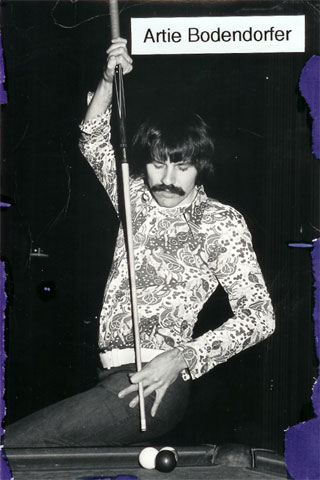
Arthur "Artie" Bodendorfer prepares to shoot a massé.
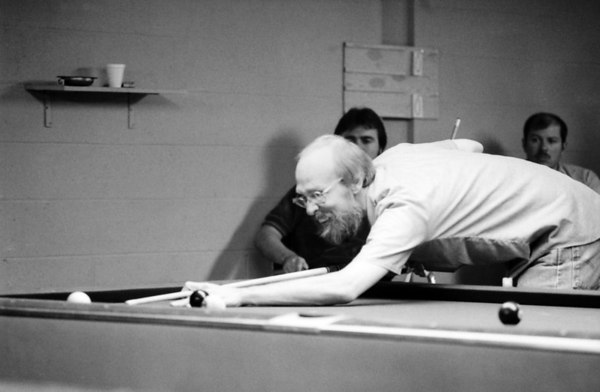
Grady "The Professor" Matthews was the first inductee into the One-Pocket Hall
of Fame, in 2004. He was the creator of the Legends of One-Pocket tournament
series and helped promote many other tournaments. (1982 photo by Mike Haines; photo editing by Bill
Porter.)
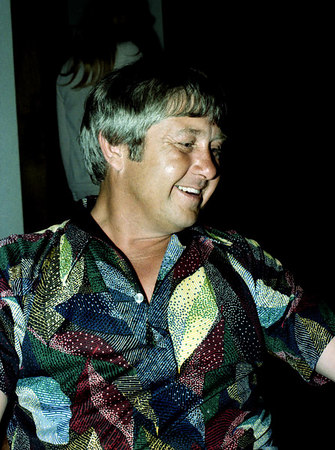
Ronnie Allen during his psychedelic days, or was it a psychedelic haze? (1980
photo by Mike Haines/Bill Porter). According to "Hippie" Jimmy Reid, Walter
Tevis, the author of The Hustler and The Color of Money
confirmed in a tape-recorded interview (while they were playing chess in a suite
at the Holiday Inn in Dayton, Ohio) that "Fast Eddie" Felson was based on Ronnie
Allen. According to Reid, "At one point during this interview, I became the
interviewer instead of interviewee, I flat out asked Mr. Tevis who he based Fast
Eddie Felson on? His reply went something like this: I went to Corcoran’s Pool
Roon in Frisco and saw a young, brash player by the name of Ronnie Allen who was
a worldbeater, got the idea for the book and the rest is fiction and history."
According to an online post on the subject by Jay Helfert, "Ronnie Allen did
have more title to the claim, based on several occurrences. He was running
around San Francisco around 1959-60 and calling himself Eddie. He was prone to
raise the bet so fast that someone (Jack Perkins maybe) started calling him Fast
Eddie. Jack told me that when he saw Ronnie come in the poolroom he called out,
'Here comes that Fast Eddie again!' Word of his exploits reached all across the
country. Even in the Midwest, word was out on this brash young kid, who was
hustling and beating the best hustlers in San Francisco. Whether Tevis ever went
out there or not I do not know. What I do know was that he was a keen observer
of the pool scene, mostly hanging in the pool rooms in Louisville and
Lexington. As far as Fats is concerned, Eddie Taylor probably had more influence
on Tevis than anyone else. Walter definitely watched Taylor in action on more
than one occasion. Eddie was a portly man who dressed immaculately and was
always a gentleman at (and away from) the table. And he was a GREAT player, the
best around, and certainly the best Tevis witnessed at that time. Any of this
sound familiar? So if we are going to give credit, let's give it where it is
due."
Per a June 2, 1987 article in the Los Angeles Times, "In those
days, Minnesota Fats said of Allen: 'Anybody who plays him for money ain't go no
chance at all. I'm the only guy in the whole world who can beat him.' (Allen
contends that he has beaten Fats. He has lost to him, as well.) It was also in
those days, as Allen tells it, that writer Walter Tevis was hanging around pool
halls, collecting material for his book, The Hustler. Allen and others
in the world of pool say that Tevis based his book on the Oklahoma City player."
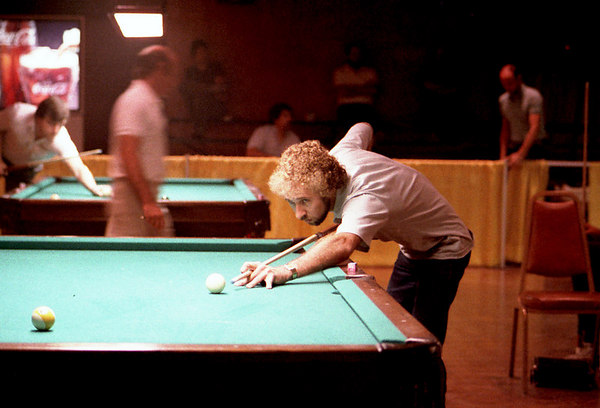
Nick Varner at the 1984 River City Open Nine-ball Tournament (photo by Mike Haines;
photo editing by Bill Porter).
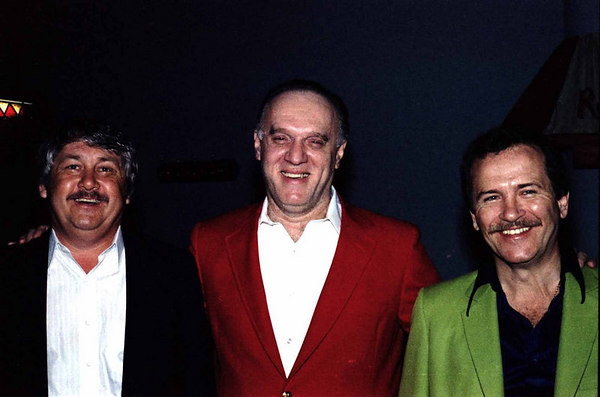
Ronnie Allen, Jack Breit and "Champagne" Ed Kelly (circa 1983-1984; photo by Mike
Haines/Bill Porter).
Bill Incardona once said while commentating on a one pocket match that nobody
shoots billiards, caroms, and combos better than Steve Cook. The Cookie Monster
ran out from everywhere, and had a high straight pool run of 189, but his weak
break handicapped him at nine ball. Allen Hopkins said in "Shots, Moves and
Strategies" that from the mid 70's through the entire 80's, Steve Cook was the
best one pocket player in the world.
"I was lucky everywhere." — Bill "Weenie Beenie" Staton, who used his pool
winnings to make millions from his hot dog stand business
The best pool stroke: Michael "Train" Coltrain, Andrew "The Gent" Gentry, "Marvelous" Marvin Henderson, "Champagne" Ed
Kelly, Johnny "Irish" Lineen, "Cowboy" Jimmy Moore, Danny Searcy, Harold Worst, Alton "Babyface" Whitlow
Andrew "The Gent" Gentry was the best player in Nashville when I was
running there; he would take on even the best pros at his specialty, bank. I saw
him play Buddy Hall, Truman Hogue, "Little" David Howard, and other top-notch
road players. Gentry had the most amazing slip stroke: he would pull the stick
completely out of his bridge hand with a long, elegant, fluid backstroke, then
bring it back through effortlessly. He could also play amazing safeties, sending
the cue ball the length of the table to "feather" an object ball, then bring the
cue back down to the opposite end of the table. While Gentry was not the best
"money" player, he was a joy to watch and a real gentleman (and a gentle man) to
boot.
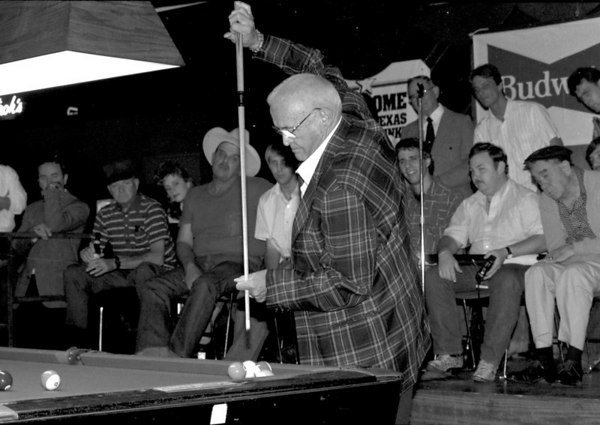
"Cowboy" Jimmy Moore either shooting a trick shot or recovering from incredibly
bad shape (1987 photo by Mike Haines; photo editing by Bill Porter).
The best cue ball control (position, or shape):
Ronnie Alcano, Johnny Archer, Marshall "Tuscaloosa Squirrel" Carpenter,
Allison "Always in Line" Fisher, Buddy "The Rifleman" Hall, Willie
Mosconi, Jim "King James" Rempe, Efren "Bata" Reyes, Mike "Captain
Hook" Sigel, Ralf Souquet, Earl "The Pearl" Strickland, Nick Varner, Krzysztof
Wróbel
The History of Pool, Part VI: Following the First World War the
popularity of pool continued to grow. The first professional snooker
championship was held in England in 1927. To illustrate the prestige with which
the game was held, when Walter Lindrum, the greatest champion of all, toured
England during 1931, he met the English Prime Minister and was summoned for a
Royal Command Performance before King George V. Over the next thirty years the
popularity of snooker skyrocketed. Following the advent of colour television,
snooker became England's most popular indoor game. Large tournaments with very
substantial prize moneys and extensive TV coverage led to a great upsurge of
interest in the game.
The History of Pool, Part VII: Did TV kill straight pool? The 1973 U.S. Open,
held in the Grand Ballroom of the Sheraton-Chicago Hotel, may have spelled the
end of straight pool as a spectator sport, thanks to TV. The finals that year
featured Steve "the Miz" Mizerak, the affable John Madden of pool, against the
notorious North Carolina hustler Luther "Wimpy" Lassiter. At that time, Mizerak
and Lassiter were the cream of the straight pool crop. Mizerak had won the three
previous U.S. Opens. Lassiter had won a slew of major tournaments during the
1960s. Both players appear in Billiard Digest's list of the top ten
players of the century. The stage was perfectly set for an epic battle, and
ABC's cameras were there to transmit it electronically to the viewing public's
couch potatoes. It was like pool's Babe Ruth squaring off against its Ty Cobb,
with everything on the line. But there was a major problem: time, compounded by
booringness. According to the New York Times, "Mizerak, unbeaten in the
double-elimination tourney, lost a marathon match that started last night and
lasted more than 4 hours, 150-110, in 22 innings." Matt Racki of the
Billiard Revue said that Mizerak played the first game "like his cue had
been in a deep freeze for a few years." And because Lassiter won, a second game
was required to determine the champion. Unfortunately, it wasn't much better for
spectators. Mizerak, usually the picture of joviality and optimism, later said
that the double marathon "just took too long to film." Pool historian Charles
Ursitti pointed out that a long stretch of safety play made for "wretched"
television. According to Ursitti, "They used to televise the U.S. Open on ABC
for years ... it was straight pool and only straight pool. For the die-hard fan,
that's what you want to see. But it can get boring, and in 1973, they got into
about 18 minutes of safety play. And of course, 18 minutes of playing safe is
extremely hard to edit. What people want to see is offense. They want to see a
lot of downtown shots. And so [the TV networks] abandoned it. CBS and ABC said,
'That's that. We're done.'" Within a few years, by 1978, the BCA (Billiard
Congress of America) had also abandoned straight pool for
nine ball. The fledgling PPPA (Professional Pool Players Association)
soon followed suit. Thus the prediction of the legendary Jansco brothers, the
first great promoters of pool, that straight pool would lose out to nine ball,
had come to pass. Why? Primarily because nine ball is faster and more
entertaining. Another important factor, no doubt, was the booming popularity of
coin-operated bar tables, which make it troublesome and expensive to spot balls.
Soon millions of pool enthusiasts were playing on tables that didn't
lend themselves to games like straight pool and one pocket, and of course
most amateurs would much rather take wildly exciting offensive risks than play
safety after mind-numbing safety. (In many bars today, playing safe is just
above pedophilia and incest on the list of "thou shalt nots.") But the original
"kiss" of death, if you'll pardon the pun, for straight pool was time's.
The best trick shot artists: Chef Anton, Paul Gerni, Mike "Tennessee Tarzan" Massey,
Stefano Pelinga, Tom Rossman, Andy Segal
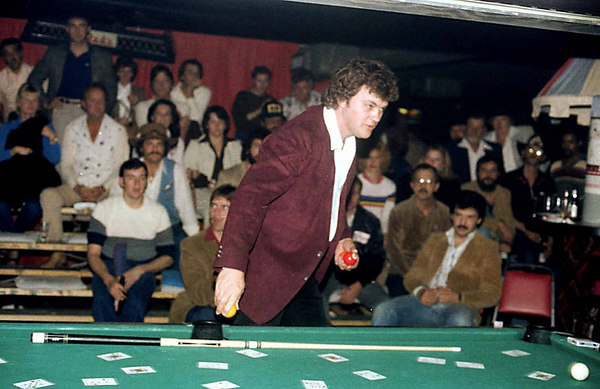
Mike "Tennessee Tarzan" Massey (circa 1983-1984 photo by Mike Haines/Bill
Porter).
The best all-round modern players (good at everything): Buddy "The Rifleman" Hall,
Jim "King James" Rempe, Efren "Bata" Reyes, Mike "Captain Hook" Sigel, Earl "The Pearl" Strickland, Nick Varner
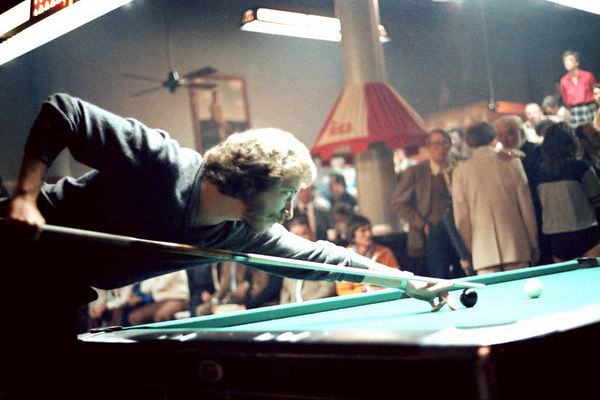
Jim "King James" Rempe won more than 100 tournaments, with multiple major
championships in all the major disciplines
Efren Reyes posed as "Caesar Morales" at his first American pool tournament
victory in 1985. Like Julius Caesar, he came, he saw, he conquered.
The best bar table "big ball" players: "Surfer" Rod Curry, Buddy "The Rifleman" Hall, "Little" David Howard, "Boston" Joey Kiley, Dave Matlock,
Keith "Earthquake" McCready, "St. Louie" Louie Roberts,
"Omaha" John Shuput, Three-Fingered Ronnie Sypher, Shane Van Boening
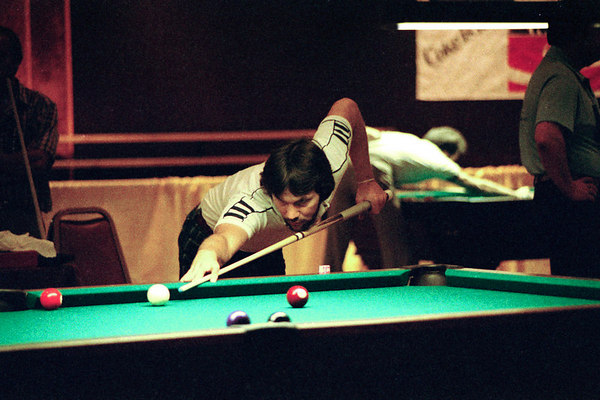
Dave Matlock (1984 photo by Mike Haines; photo editing by Bill Porter). If there
is any consensus in the pool world, it is probably that Dave Matlock was the
best "bar box" player with the "big ball."
The best three cushion billiard players: Torbjörn Blomdahl, Raymond Ceulemans,
Roland Forthomme, Willie "The King" Hoppe, Dick Jaspers, Johnny
Layton, Sang Lee, Alfredo de Oro, Harold Worst, Jake "The Wizard" Schaefer Sr., Jake Schaefer Jr.
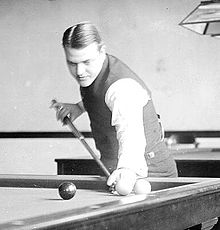
Willie "The King" Hoppe,
circa 1910.
Hoppe held the record for consecutive billiards made, 26, for fifty years. He
won 51 world titles in three-cushion billiards, four variations of balkline billiards, and cushion
caroms.
Hoppe was the only pocket billiards player to ever put on an
exhibition in the White House, where he performed for President William Taft in 1911. Hoppe was first
in the Billiards Digest rankings of the 50 Greatest Players of the
Century.
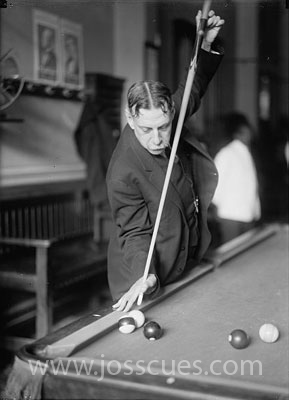
Alfredo de Oro, circa 1914.
He won world titles in three-cushion billiards and straight
pool/continuous pool, and sometimes held them simultaneously. De Oro was fourth
in the Billiards Digest rankings of the 50 Greatest Players of the
Century.
The best snooker players: Steve Davis, Stephen Hendry, Alex "Hurricane" Higgins, Ronnie
O'Sullivan, Ray Reardon, Mark Selby, Krzysztof Wróbel
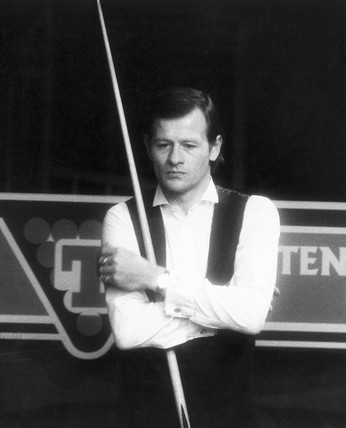
Alex "Hurricane" Higgins
The best eight ball players: Darren Appleton, Johnny "The Scorpion" Archer,
Nick "El Nino" van den Berg, Shane Van Boening,
Rodney Morris, Alex "The Lion" Pagulayan, Efren Reyes,
Ralf Souquet, Jayson Shaw

Johnny "The Scorpion" Archer
The best break: Shane Van Boening, Wade "Boom Boom" Crane, "Hurricane"
Tony Ellin, "Little" David Howard, Chuck Morgan, Earl
"The Pearl" Strickland
A former world 8-ball and nine-ball champion, Wade Crane was voted by his peers to have
had
the best nine-ball break in history.
The best safeties:
Eugene "Clem" Metz, Mike "Captain Hook" Sigel, Efren "Bata" Reyes
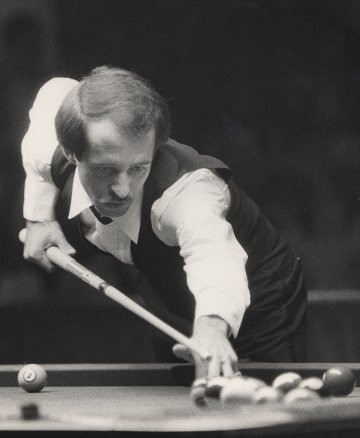
Mike "Captain Hook" Sigel
was fifth in the Billiards Digest rankings of the 50 Greatest
Players of the Century, and highest among modern nine-ball players.
The best kickers (kick shot artists): Shannon "The Cannon" Daulton,
Jose Parica, Efren "Bata" Reyes,
Danny "High Heels" Tator, Glen "The Eufaula Kid" Womack
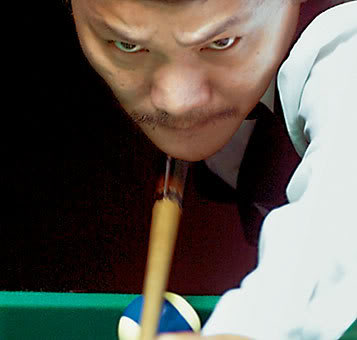
Efren "Bata" Reyes,
aka "the Magician," eying a shot intensely.
"Oil Can" Larry" Lisciotti's nickname has been attributed to Jimmy Mataya, who
called him a "handsome, high-living, high-rolling pool hustler, lidded eyes,
slightly lascivious grin—a wasted sharpshooter, a well oiled gunslinger of the
70's."
Mark Twain, Was
Minnesota Fats Overrated?,
A Brief History of Billiards,
Pool/Billiards Record High
Runs, The Sexiest Sharks,
Johnston City Sharks,
Nashville Sharks,
Dick Hunzicker,
"Saint Louie"
Louie Roberts, Earl "The
Pearl" Strickland,
Who
was the best nine-ball player?, Famous Rogues,
Famous Frauds,
Famous Americans,
The
Best Donald Trump Jokes, Famous Geniuses,
Famous Confessionals,
Famous Firsts,
Famous Super Couples
The HyperTexts















































